Awards and Decorations
Concerning awards, Army Regulation 600–8–22 is regulation that provides Department of the Army policy, criteria, and administrative instructions in regards to individual military decorations, Army Good Conduct Medals, service medals and ribbons, combat and special skill badges and tabs, and unit decorations. It also provides the same for trophies, and similar device awards in recognition of accomplishments. Further, it lays out the policies and procedures regarding United States Army awards to foreign military personnel of all ranks and branches as well as foreign decorations and awards to U.S. Army personnel.
AR 600-8-22 applies to the Regular Army, the Army National Guard/Army National Guard of the United States, and the U.S. Army Reserve awards, unless otherwise stated. In addition to that, it applies to retired military personnel of all branches, foreign military personnel, and Department of Defense Civilians, as indicated.
The regulation is broken down into seven primary sections as follows:
- Overview
- Responsibilities
- Principles and Standards
- Policy, Precedence, and Information
- Order of Precedence
- Supply, Service, and Requisition
- Reporting Requirements and Filing Instructions

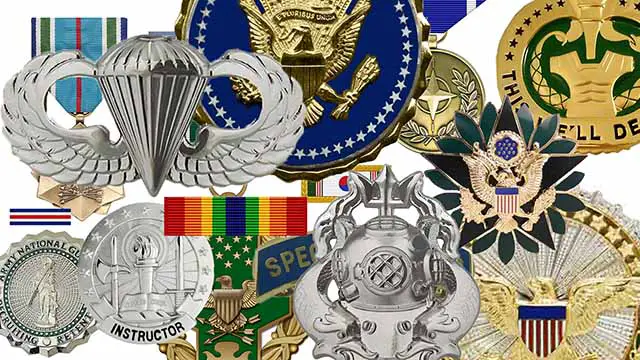
Department of Defense Awards and Decorations
The objective of the Department of Defense Military Awards Program is to ensure that Service Members of the Armed Forces of the United States receive material recognition for the acts they perform and the behavior that they display. These acts and behaviors include acts of valor, exceptional service or achievement, and acts of heroism not involving actual combat.
The Order of precedence regarding DOD awards are categorized as U.S. military decorations, and campaign, expeditionary, and service medals. You can find the order of precedence for how these awards are worn in Army Regulation 670–1.
Individual Department of Defense Decorations
There are six awards issued to individuals at the Department of Defense level.
Defense Distinguished Service Medal
 Established on 9 July, 1970, the Defense Distinguished Service Medal is awarded by the Secretary of Defense to officers of the Armed Forces of the United States whose exceptional performance of duty and contributions to national security or defense have been at the highest levels. It is both the United States’s highest of non-combat related military awards and the highest of the joint service decoration awards.
Established on 9 July, 1970, the Defense Distinguished Service Medal is awarded by the Secretary of Defense to officers of the Armed Forces of the United States whose exceptional performance of duty and contributions to national security or defense have been at the highest levels. It is both the United States’s highest of non-combat related military awards and the highest of the joint service decoration awards.
The Defense Distinguished Service Medal is gold in color. It features a medium blue enameled pentagon (point up) on the side that bears the principal design. There is an American bald eagle superimposed with its wings outspread and the head facing left. The eagle is grasping three crossed arrows in its talons. A shield of the United States is on its breast.
The pentagon and eagle are enclosed within a gold pieced circle that has 13 five-pointed stars (upper half) and a wreath of laurel on the left and olive on the right (lower half). There is a suspender of five graduated gold rays at the top.
The back of the Defense Distinguished Service Medal bears the inscription “For Distinguished Service” at the top in raised letters, and (within the pentagon) the inscription “From The Secretary of Defense To (name and rank),” all in raised letters.
Defense Superior Service Medal
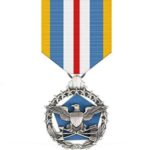 Established on 6 February 1976, the Defense Superior Service Medal is awarded by the Secretary of Defense to service members of the Armed Forces of the United States who, after that date, rendered superior meritorious service in a position of significant responsibility.
Established on 6 February 1976, the Defense Superior Service Medal is awarded by the Secretary of Defense to service members of the Armed Forces of the United States who, after that date, rendered superior meritorious service in a position of significant responsibility.
The Defense Superior Service Medal uses the same design as the Defense Distinguished Service Medal. The differences are that it is finished in silver instead gold and the inscriptions on the back side of the medal are modified to reflect the difference between the awards.
Defense Meritorious Service Medal
 Established on 3 November 1977, the Defense Meritorious Service Medal (DMSM) is awarded in the name of the Secretary of Defense to service members of the Armed Forces of the United States who have distinguished themselves by non-combat meritorious achievement or service. It is not used to recognize meritorious service or achievement under combat conditions (Bronze Star Medal).
Established on 3 November 1977, the Defense Meritorious Service Medal (DMSM) is awarded in the name of the Secretary of Defense to service members of the Armed Forces of the United States who have distinguished themselves by non-combat meritorious achievement or service. It is not used to recognize meritorious service or achievement under combat conditions (Bronze Star Medal).
The Defense Meritorious Service Medal is made of bronze. It is 1 1⁄2 inches (38 mm) in diameter. There is a circular wreath of laurel leaves tied with a ribbon at base on the side that bears the principal design. There is a pentagon shape in the center which slightly overlaps the wreath. An eagle with wings upraised standing at the base of the pentagon is superimposed over the pentagon. The eagle represents the United States while the pentagon shape points to the Department of Defense. The laurel wreath represents achievement.
The back side of the medal bears the inscription, Defense Meritorious Service in three horizontal lines. Below that is a space for engraving the name of the recipient. Below the space, you will find the words “United States of America”.
Joint Service Commendation Medal
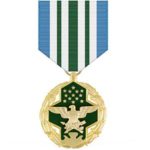 Authorized on 25 June 1963 by the Secretary of Defense, the Joint Service Commendation Medal is awarded to Servicemembers of the Armed Forces of the United States who distinguished themselves by meritorious achievement or service after 1 January 1963 .
Authorized on 25 June 1963 by the Secretary of Defense, the Joint Service Commendation Medal is awarded to Servicemembers of the Armed Forces of the United States who distinguished themselves by meritorious achievement or service after 1 January 1963 .
The Joint Service Commendation Medal consists of four conjoined hexagons of green enamel. There is an eagle in gold at the center with outspread wings. The eagle is grasping three arrows in its talons (as depicted on the seal of the Department of Defense). Above the eagle are 13 gold stars, and at the base is a gold stylized heraldic delineation representing land, sea, and air. This design is enclosed by a circular wreath of laurel bound with bands, also in gold.
On the back, there is a tablet in the center that is suitable for engraving, and the words “For Military Merit.” There is also a sprig of laurel at the bottom.
Joint Service Achievement Medal
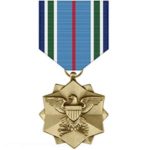 Authorized by the Secretary of Defense on 3 August 1983, the Joint Service Achievement Medal awards are granted to service members of the Armed Forces of the United States below the grade of 0-6 (Colonel) who, after 3 August 24, distinguished themselves by outstanding performance of duty and meritorious achievement.
Authorized by the Secretary of Defense on 3 August 1983, the Joint Service Achievement Medal awards are granted to service members of the Armed Forces of the United States below the grade of 0-6 (Colonel) who, after 3 August 24, distinguished themselves by outstanding performance of duty and meritorious achievement.
The Joint Service Achievement Medal is in the shape of a 12 pointed star. The front features an American bald eagle, facing left with wings spread. It is grasping three arrows and has a shield upon its breast as adapted from the seal of the Department of Defense. The back side of the medal bears the inscription, “Joint Service Achievement Award” in raised letters in circular form in the center.
Purple Heart
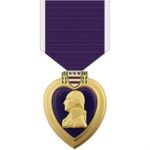 The Purple Heart was originally established by General George Washington on 7 August 1782. It was reestablished on 22 February 1932. The Purple Heart differs from all other decorations in that an individual is not “recommended” for the decoration. Instead of a recommendation, rather, an individual is entitled to it upon meeting specific criteria.
The Purple Heart was originally established by General George Washington on 7 August 1782. It was reestablished on 22 February 1932. The Purple Heart differs from all other decorations in that an individual is not “recommended” for the decoration. Instead of a recommendation, rather, an individual is entitled to it upon meeting specific criteria.
It is awarded in the name of the President of the United States to any member of an Armed Force of the United States under the jurisdiction of the Secretary of the Army who, after 5 April 1917, has been wounded, killed, or who has died or may hereafter die of wounds received, under specified circumstances.
The Purple Heart award is a heart-shaped medal within a gold border. The border is 1 3⁄8 inches (35 mm) wide. The face of the medal contains a profile of General George Washington. A shield of the coat of arms of George Washington (a white shield with two red bars and three red stars in chief) between sprays of green leaves above the heart. The back side of the Purple Heart features a raised bronze heart with the words “For Military Merit” below the coat of arms and leaves.

Department of Defense Campaign, Expeditionary, and Service Medals and Ribbons
According to Army Regulation 600-8-22, the following 25 awards are issued at the Department of Defense level under the categories of Campaign, Expeditionary, and Service Medals and Ribbons.
Prisoner of War Medal
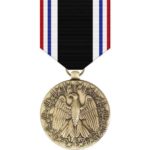 The Prisoner of War Medal (POW) is authorized for any person who, while serving in any capacity with the U.S. Armed Forces, was taken prisoner and held captive after 5 April 1917. The POW Medal is to be issued only to those U.S. military personnel and other personnel granted creditable U.S. military service, who were taken prisoner and held captive:
The Prisoner of War Medal (POW) is authorized for any person who, while serving in any capacity with the U.S. Armed Forces, was taken prisoner and held captive after 5 April 1917. The POW Medal is to be issued only to those U.S. military personnel and other personnel granted creditable U.S. military service, who were taken prisoner and held captive:
- While engaged in an action against an enemy of the United States.
- While engaged in military operations involving conflict with an opposing foreign force.
- While serving with friendly forces engaged in an armed conflict against an opposing armed force in which the United States is not a belligerent party.
The Prisoner of War Medal is a circular bronze medal. It is 1 3/8 inches in diameter. The face of the medal features an eagle with wings opened surrounded by a circle of barbed wire and bayonet points. The back side features the inscription “Awarded To” near the top. Below that is a space for engraving the name of the recipient. Below the space is an additional description reading “For Honorable Service While a Prisoner of War” across the center in three lines. The shield of the Coat of Arms of the United States is centered on the lower part of the back side with the inscription “United States of America” around the bottom of the medal.
National Defense Service Medal
 The National Defense Service Medal was established on 18 October 1991. It may be awarded for both active and reserve service. There is no known document that explains the rationale for the award. Apparently, it was first established to recognize all service members who served during the Korean War including those who did not serve in the war zone.
The National Defense Service Medal was established on 18 October 1991. It may be awarded for both active and reserve service. There is no known document that explains the rationale for the award. Apparently, it was first established to recognize all service members who served during the Korean War including those who did not serve in the war zone.
It is awarded for honorable active service for any period between:
- 27 June 1950 and 27 July 1954 (Korea)
- 1 January 1961 and 14 August 1974 (Vietnam)
- 2 August 1990 and 30 November 1995 (Persian Gulf)
- 11 September 2001 to a date to be determined (Global War on Terrorism).
Antarctica Service Medal
 The Antarctica Service Medal was established in 1960. These awards are issued in the name of the U.S. Department of Defense. It is awarded to any person who, after 2 January 1946 and before a date to be announced, meets any of the following qualifications:
The Antarctica Service Medal was established in 1960. These awards are issued in the name of the U.S. Department of Defense. It is awarded to any person who, after 2 January 1946 and before a date to be announced, meets any of the following qualifications:
- Personnel must train or serve ten days stationed on the Antarctic continent, or aboard vessels in Antarctic waters, defined as south of 60 degrees latitude.
- Flight crews performing transport missions to Antarctica qualify for one day of service for each flight mission performed within a 24-hour time period.
- Civilians who work in a research facility or on a research vessel are also eligible to receive the Antarctica Service Medal through the National Science Foundation, provided that they also remain south of 60 degrees latitude for a cumulative period of 10 days, or 30 days if prior to October 10, 2008.
The Antarctica Service Medal is a circular bronze medal that is 1 1⁄4 inches in diameter. The front side features a polar landscape view and standing figure in Antarctica clothing facing to the front between the horizontally placed words, “ANTARCTICA” to the left and “SERVICE” to the right.
On the back side there is a polar projection with geodesic lines of the continent of Antarctica. The words “COURAGE”, “SACRIFICE”, and “DEVOTION” cross the continent horizontally. This design lies within a circular decorative border of penguins and marine life.
Armed Forces Expeditionary Medal
 Established on 4 December 1961, the Armed Forces Expeditionary Medal may be awarded to Servicemembers of the Armed Forces of the United States. The medal shall be awarded only for operations for which no other U.S. campaign medal is approved, where a foreign armed opposition or imminent threat of hostile action was encountered.
Established on 4 December 1961, the Armed Forces Expeditionary Medal may be awarded to Servicemembers of the Armed Forces of the United States. The medal shall be awarded only for operations for which no other U.S. campaign medal is approved, where a foreign armed opposition or imminent threat of hostile action was encountered.
The Armed Forces Expeditionary Medal is a circular bronze medal that is 1 ¼ inches in diameter. The face of the medal features an eagle, with wings addorsed and inverted, standing on a sword loosened in its scabbard. The eagle is superimposed on a radiant compass rose of eight points. This is surrounded by the circumscription “ARMED FORCES” above and “EXPEDITIONARY SERVICE” below. There is also a sprig of laurel on each side.
On the back side, lies the shield from the United States Coat of Arms above two laurel branches separated by a bullet. This is surrounded by the circumscription “UNITED STATES OF AMERICA”.
Vietnam Service Medal
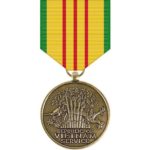 The Vietnam Service Medal was established on 2 February 2003. It is awarded to all service members of the Armed Forces of the United States serving in Vietnam and its contiguous waters or airspace, after 3 July 1965 through 28 March 1973. Service members of the Armed Forces of the United States in Thailand, Laos, or Cambodia, or the accompanying airspace during the same period and serving in direct support of operations in Vietnam are also eligible for this award.
The Vietnam Service Medal was established on 2 February 2003. It is awarded to all service members of the Armed Forces of the United States serving in Vietnam and its contiguous waters or airspace, after 3 July 1965 through 28 March 1973. Service members of the Armed Forces of the United States in Thailand, Laos, or Cambodia, or the accompanying airspace during the same period and serving in direct support of operations in Vietnam are also eligible for this award.
The Vietnam Service Medal is a circular bronze medal that is 1 1⁄4 inches in diameter. It has a green, yellow, and red suspension ribbon. The front side of the medal features a figure of an oriental dragon (representing the subversive nature of the conflict) behind a grove of bamboo trees. Below this is the inscription “REPUBLIC OF VIETNAM SERVICE”.
The back side features a crossbow (representing the ancient weapon of Vietnam) facing upwards with a ready to be fired lighted torch of the Statue of Liberty. Below this is an arched inscription “UNITED STATES OF AMERICA”
Southwest Asia Service Medal
 The Southwest Asia Service Medal was established on 12 March 1991. It is awarded to all service members of the Armed Forces of the United States serving in Southwest Asia and contiguous waters or accompanying airspace, on or after 2 August 1990 to 30 November 1995. The geographical area includes the Persian Gulf, Red Sea, Gulf of Oman, Gulf of Aden, that portion of the Arabian Sea that lies north of 10 degrees north latitude and west of 68 degrees east longitude, as well as the total land areas of Iraq, Kuwait, Saudi Arabia, Oman, Bahrain, Qatar, and United Arab Emirates.
The Southwest Asia Service Medal was established on 12 March 1991. It is awarded to all service members of the Armed Forces of the United States serving in Southwest Asia and contiguous waters or accompanying airspace, on or after 2 August 1990 to 30 November 1995. The geographical area includes the Persian Gulf, Red Sea, Gulf of Oman, Gulf of Aden, that portion of the Arabian Sea that lies north of 10 degrees north latitude and west of 68 degrees east longitude, as well as the total land areas of Iraq, Kuwait, Saudi Arabia, Oman, Bahrain, Qatar, and United Arab Emirates.
The Southwest Asia Service Medal is a circular bronze medal 1 ¼ inches wide, with the words “SOUTHWEST ASIA SERVICE” across the center background. Above the center is a desert scene with a tank, armored personnel carrier, helicopter and camels with the rising sun in the background. Below the center is a seascape with ship, tanker, aircraft and clouds in the background. On the reverse, is an upraised sword entwined with a palm frond and “UNITED STATES OF AMERICA” around the edge.
Kosovo Campaign Medal
 The Kosovo Campaign Medal was established on 3 May 2000. It is awarded to service members of the Armed Forces of the United States who, after 24 March 1999, who participated in or served in direct support of Kosovo Operations. They must have:
The Kosovo Campaign Medal was established on 3 May 2000. It is awarded to service members of the Armed Forces of the United States who, after 24 March 1999, who participated in or served in direct support of Kosovo Operations. They must have:
- Been engaged in actual combat, or duty that is equally as hazardous as combat duty, during the operation with armed opposition, regardless of time in the area of operations;
- While participating in the operation, regardless of time, is wounded or injured and requires medical evacuation from the area of operations.
- While participating as a regularly assigned aircrew member flying sorties into, out of, within, or over the area of operations in direct support of the military operations
The kosovo Campaign Medal is a circular bronze medal featuring two mountains with a pass between them rest in front of a fertile valley and atop a wreath composed of two stylized sheaves of wheat. Behind the mountains a rising sun, and superimposed over the sun’s rays are the words, in two lines, KOSOVO CAMPAIGN.
On the back, there is an outline of a map of the Yugoslavian Province of Kosovo in the center. Beneath the map is a three-pointed star. In a circle surrounding the map and star are the words “IN DEFENSE OF HUMANITY”. It is combined with the NATO star, the highlighted cardinal points of the compass.
Afghanistan Campaign Medal
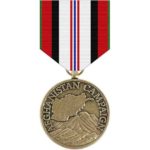 The Afghanistan Campaign Medal was authorized on 12 March 2003. It is awarded to any member of the United States military who has performed duty within the borders of Afghanistan (or its airspace) for a period of thirty consecutive days or sixty non-consecutive days. It is also awarded posthumously to any service member who dies in the line of duty within Afghanistan, including from non-combat injuries such as accidents and mishaps.
The Afghanistan Campaign Medal was authorized on 12 March 2003. It is awarded to any member of the United States military who has performed duty within the borders of Afghanistan (or its airspace) for a period of thirty consecutive days or sixty non-consecutive days. It is also awarded posthumously to any service member who dies in the line of duty within Afghanistan, including from non-combat injuries such as accidents and mishaps.
The Afghanistan Campaign Medal is a circular bronze medal that is 1 1⁄4 inches in diameter. It shows a range of mountains below a map of Afghanistan. Near the top it bears the inscription “AFGHANISTAN CAMPAIGN.”
On the back, there is a radiating demi-sun that is superimposed by an eagle’s head couped. Inscribed across the bottom half of the reserve side are the three lines “For Service in Afghanistan”, enclosed by a laurel wreath.
Iraq Campaign Medal
 The Iraq Campaign Medal was authorized on 12 March 2003. Individuals authorized ICM awards must have served in direct support of Operation IRAQI FREEDOM (OIF) or Operation NEW DAWN (OND). The AOE encompasses all land area of the country of Iraq, and the contiguous water, airspace, and land areas out to 12 nautical miles.
The Iraq Campaign Medal was authorized on 12 March 2003. Individuals authorized ICM awards must have served in direct support of Operation IRAQI FREEDOM (OIF) or Operation NEW DAWN (OND). The AOE encompasses all land area of the country of Iraq, and the contiguous water, airspace, and land areas out to 12 nautical miles.
The Iraq Campaign Medal is circular bronze medal that is 1 1⁄4 inches (32mm) in diameter. The front shows a north-oriented relief of the map of Iraq, surmounted by two lines representing the Tigris and Euphrates rivers throughout. This is superimposed over a palm wreath with the inscription “IRAQ CAMPAIGN” below.
The back side features the Statue of Freedom surmounting a sunburst and encircled by two scimitars pointing down with the blades crossing at the tips. The inscription “For Service in Iraq” lies below.
Inherent Resolve Campaign Medal
 The Inherent Resolve Campaign Medal was established on 30 March 2016. It is issued to service members Individuals who have served in direct support of Operation INHERENT RESOLVE (OIR). The area of operation encompasses the land area of the countries of Iraq and Syria including the contiguous waters, airspace, and land of each extending out to 12 nautical miles.
The Inherent Resolve Campaign Medal was established on 30 March 2016. It is issued to service members Individuals who have served in direct support of Operation INHERENT RESOLVE (OIR). The area of operation encompasses the land area of the countries of Iraq and Syria including the contiguous waters, airspace, and land of each extending out to 12 nautical miles.
The Inherent Resolve Campaign Medal is a circular bronze medal featuring a mailed fist and dagger on the face impaling a scorpion. The scorpion is said to represent “strength and courage in the defense of liberty and freedom”. The scorpion being impaled was chosen because, “The scorpion, symbolic for treachery and destruction, is found on most major land masses.”
Global War on Terrorism Expeditionary Medal
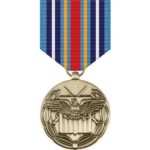 The Global War on Terrorism Expeditionary Medal was established on 12 March 2003 to recognize service members of the Armed Forces of the United States who are deployed abroad for service in the Global War on Terrorism on or after 11 September 2001 to a date to be determined.
The Global War on Terrorism Expeditionary Medal was established on 12 March 2003 to recognize service members of the Armed Forces of the United States who are deployed abroad for service in the Global War on Terrorism on or after 11 September 2001 to a date to be determined.
The medal is made of bronze and features the esteemed eagle insignia.
Global War on Terrorism Service Medal
 The Global War on Terrorism Service Medal was established on 12 March 2003 to award Servicemembers of the Armed Forces of the United States who have participated in or served in support of a Global War on Terrorism operations outside of the designated areas of operation.
The Global War on Terrorism Service Medal was established on 12 March 2003 to award Servicemembers of the Armed Forces of the United States who have participated in or served in support of a Global War on Terrorism operations outside of the designated areas of operation.
The medal is a bronze circular medal that is 1.25 inches in diameter. The front features an eagle with spread wings. On the breast of the eagle is a shield of thirteen vertical bars. In the eagle’s right claw is an olive branch and in the left claw are three arrows. A terrestrial globe surmounts the eagle. The inscription “War on Terrorism Service Medal” lies above.
There is a laurel wreath on a plain field on the back side.
Korea Defense Service Medal
 The Korea Defense Service Medal was authorized by National Defense Authorization Act in 2003. It is authorized for award to service members of the Armed Forces of the United States who have served on active duty in support of the defense of the Republic of Korea.
The Korea Defense Service Medal was authorized by National Defense Authorization Act in 2003. It is authorized for award to service members of the Armed Forces of the United States who have served on active duty in support of the defense of the Republic of Korea.
The Korea Defense Service Medal is a circular bronze medal that is 1 1⁄4 inches (32 mm) in diameter. The front bears a Korean “circle dragon”, surrounded by a scroll inscribed “Korea Defense Service”. There are two sprigs at the base with a laurel on the left and bamboo on the right. The back side bears an outline of the Korean Peninsula surmounted by two crossed swords, pointed up. There is a decorative circlet with five points around the edge.
Armed Forces Service Medal
 The Armed Forces Service Medal was established on 11 January 1996. It is awarded to service members of the Armed Forces of the United States who, after 1 June 1992 participate or have participated, as Servicemembers of U.S. military units, in a U.S. military operation that is deemed to be a significant activity. And, have not encountered foreign-armed opposition or imminent threat of hostile action.
The Armed Forces Service Medal was established on 11 January 1996. It is awarded to service members of the Armed Forces of the United States who, after 1 June 1992 participate or have participated, as Servicemembers of U.S. military units, in a U.S. military operation that is deemed to be a significant activity. And, have not encountered foreign-armed opposition or imminent threat of hostile action.
The Armed Forces Service Medal is a circular bronze medal that is 1 1⁄4 in (32 mm) in diameter. The front bears a demi-torch, as held by the Statue of Liberty, with rays radiating from behind the torch. The inscription Armed Forces Service Medal encircles the top.
The back side bears the eagle found on the United States Department of Defense seal. There is a laurel wreath with the inscription “In Pursuit of Democracy” at the top.
Humanitarian Service Medal
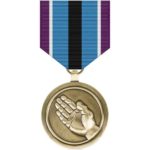 The Humanitarian Service Medal was established on 19 January 1977. It is awarded to Servicemembers of the Armed Forces of the United States who, after 1 April 1975, distinguished themselves by meritorious direct participation in a Department of Defense or Department of the Army approved significant military act or operation of a humanitarian nature.
The Humanitarian Service Medal was established on 19 January 1977. It is awarded to Servicemembers of the Armed Forces of the United States who, after 1 April 1975, distinguished themselves by meritorious direct participation in a Department of Defense or Department of the Army approved significant military act or operation of a humanitarian nature.
The front of the medal features a right hand pointing diagonally upward with open palm within a circle (to symbolize a giving or helping hand).
The back features the inscription, “For Humanitarian Service” in three lines at the top. There is an oak branch, with three leaves and three acorns below that. The inscription, “United States Armed Forces” circles around the outside edge of the medal.
Military Outstanding Volunteer Service Medal
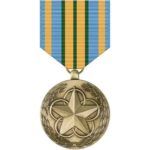 The Military Outstanding Volunteer Service Medal was originally established on 9 January 1993. It may be awarded to service members of the Armed Forces of the United States and their Reserve Components who, subsequent to 31 December 1992, perform outstanding volunteer community service of a sustained, direct, and consequential nature.
The Military Outstanding Volunteer Service Medal was originally established on 9 January 1993. It may be awarded to service members of the Armed Forces of the United States and their Reserve Components who, subsequent to 31 December 1992, perform outstanding volunteer community service of a sustained, direct, and consequential nature.
This is a circular bronze medal that is 1 1/8 inches in diameter. The front side bears five interlaced annulets behind a five-pointed star, surrounded by a laurel wreath. The back side features an oak sprig with three leaves and two acorns between the inscription “Outstanding Volunteer Service” above and “United States Armed Forces” below.
Armed Forces Reserve Medal
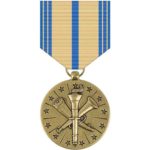 The Armed Forces Reserve Medal was established in 1950. It recognizes service performed by members of the reserve components and is awarded to both officers and enlisted personnel.
The Armed Forces Reserve Medal was established in 1950. It recognizes service performed by members of the reserve components and is awarded to both officers and enlisted personnel.
The front of the medal features a a flaming torch in front of a crossed powder horn and a bugle within a circle composed of thirteen stars and thirteen rays. The back is struck in two designs for award to personnel whose Reserve Component service has been primarily in the organized Reserve or primarily in the National Guard. The first design portrays the Minute Man from the Organized Reserve Crest; the other design portrays the National Guard insignia. It is a circular bronze medal at 1 1/4 inches in diameter.
Korean Service Medal
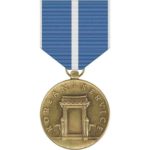 The Korean Service Medal was established on 8 November 1950. It is the primary US military award for participation in the Korean War and is awarded to any US service member who performed duty in South Korea between June 27, 1950 and July 27, 1954. This circular bronze medal features a “Korean gateway,” most likely an iljumun, on the front, and a taegeuk on the reverse.
The Korean Service Medal was established on 8 November 1950. It is the primary US military award for participation in the Korean War and is awarded to any US service member who performed duty in South Korea between June 27, 1950 and July 27, 1954. This circular bronze medal features a “Korean gateway,” most likely an iljumun, on the front, and a taegeuk on the reverse.
Medal of Humane Action
 The Medal of Humane Action was established by an Act of Congress 20 July 1949. It is awarded to service members of the Armed Forces of the United States and to other persons when recommended for meritorious participation, for service while participating in the Berlin Airlift or in direct support thereof.
The Medal of Humane Action was established by an Act of Congress 20 July 1949. It is awarded to service members of the Armed Forces of the United States and to other persons when recommended for meritorious participation, for service while participating in the Berlin Airlift or in direct support thereof.
It is a circular bronze medal that is 1.25 inches (32 mm) in diameter. The front depicts a Douglas C-54 Skymaster over a wheat wreath. At the center of the wreath is the Coat of arms of Berlin. The back side of the medal features the eagle, shield, and arrows from the seal of the Department of Defense and reads, “For Humane Action / To Supply Necessities of Life to the People of Berlin Germany”.
World War II Victory Medal
 The World War II Victory Medal was established by an Act of Congress on 6 July 1945. It is awarded for service between 7 December 1941 and 31 December 1946, both dates inclusive with no minimum time in service requirement. As every member of the United States Armed Forces who served from 7 December 1941 to 31 December 1946 was eligible for the medal, there were over 12 million eligible recipients, making the World War II Victory Medal the second most widely awarded military award of the United States, after the National Defense Service Medal.
The World War II Victory Medal was established by an Act of Congress on 6 July 1945. It is awarded for service between 7 December 1941 and 31 December 1946, both dates inclusive with no minimum time in service requirement. As every member of the United States Armed Forces who served from 7 December 1941 to 31 December 1946 was eligible for the medal, there were over 12 million eligible recipients, making the World War II Victory Medal the second most widely awarded military award of the United States, after the National Defense Service Medal.
The circular bronze medal is 1 4⁄8 inches in width. The front features a figure of Liberation standing full length with head turned to dexter looking to the dawn of a new day, right foot resting on a war god’s helmet with the hilt of a broken sword in the right hand and the broken blade in the left hand. The inscription “World War II” is placed immediately below the center.
The back side has inscriptions for the Four Freedoms: “Freedom from Fear and Want” and “Freedom of Speech and Religion” separated by a palm branch. A circle composed of the words “United States of America 1941-1945” circles the outside.
European – African – Middle Eastern Campaign Medal
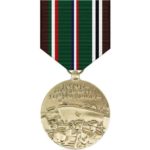 The European-African-Middle Eastern Campaign Medal was established in 1942. It is awarded for service within the European-African-Middle Eastern Theater between 7 December 1941 and 8 November 1945 with the intent to recognize those military service members who had performed military duty in the European Theater (to include North Africa and the Middle East) during the years of the Second World War.
The European-African-Middle Eastern Campaign Medal was established in 1942. It is awarded for service within the European-African-Middle Eastern Theater between 7 December 1941 and 8 November 1945 with the intent to recognize those military service members who had performed military duty in the European Theater (to include North Africa and the Middle East) during the years of the Second World War.
The circular bronze medal is 1 3⁄8 inches (35 mm) in diameter. It features a LST landing craft and troops landing under fire with an airplane in the background below the words “European African Middle Eastern Campaign” on the front.
The back side features an American bald eagle enclosed between the dates 1941 – 1945 and the words “United States of America.”
Asiatic – Pacific Campaign Medal
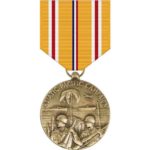 The Asiatic-Pacific Campaign Medal was established on 15 March 1946. It is awarded for service with the Asiatic-Pacific Theater between 7 December 1941 and 2 March 1946. First issued as a service ribbon in 1942. A full medal was authorized in 1947.
The Asiatic-Pacific Campaign Medal was established on 15 March 1946. It is awarded for service with the Asiatic-Pacific Theater between 7 December 1941 and 2 March 1946. First issued as a service ribbon in 1942. A full medal was authorized in 1947.
The circular bronze medal is 1.25 inches in diameter. The front of the medal depicts a tropical landing with a palm tree beneath the words Asiatic-Pacific Campaign.
American Campaign Medal
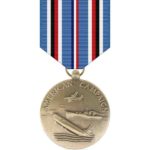 The American Campaign Medal was established on 15 March 1946. The medal was intended to recognize those military members who had performed military service in the American Theater of Operations during World War II. It is similar to the American Defense Service Medal which was awarded for active duty service before the United States entry into World War II. The main difference between the two awards is the timeframe.
The American Campaign Medal was established on 15 March 1946. The medal was intended to recognize those military members who had performed military service in the American Theater of Operations during World War II. It is similar to the American Defense Service Medal which was awarded for active duty service before the United States entry into World War II. The main difference between the two awards is the timeframe.
A circular bronze medal, the American Campaign Medal is 1 1⁄4 inches (32 mm) inches wide. The front side shows a Navy cruiser underway with a B-24 Liberator bomber flying overhead. There is a sinking enemy submarine in the foreground and the skyline of a city in the background.. The words “American Campaign” are across the top.
The back side has the same design as the back of the Asiatic-Pacific Campaign Medal and the European-African-Middle Eastern Campaign Medal awards. It shows an American bald eagle between the dates 1941 – 1945 and the words “United States of America.”
Women’s Army Corps Service Medal
 The Women’s Army Corps Service Medal was established in 1943. It is awarded for service in the Women’s Army Auxiliary Corps (10 July 1942 thru 31 August 1943) and the Women’s Army Corps (1 September 1943 thru 2 September 1945). Essentially, it was intended to recognize the service of women to the Army during the Second World War.
The Women’s Army Corps Service Medal was established in 1943. It is awarded for service in the Women’s Army Auxiliary Corps (10 July 1942 thru 31 August 1943) and the Women’s Army Corps (1 September 1943 thru 2 September 1945). Essentially, it was intended to recognize the service of women to the Army during the Second World War.
The front of the Women’s Army Corps Service Medal features Pallas Athena, helmeted and in profile with a sword and oak leaves behind her head. The image is encircled by an inscription reading “WOMEN’S ARMY CORPS.”
The back of the medal is decorated with stars and features an eagle bearing a scroll that reads “For Service in the Women’s Army Auxiliary Corps” with the years “1942-1943” appearing on the bottom of the medal.
American Defense Service Medal
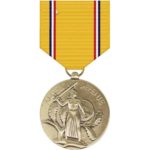 The American Defense Service Medal was established in 1941. It is awarded for service between 8 September 1939 and 7 December 1941 under orders to active duty for a period of 12 months or longer. It is similar to the American Campaign Medal (service in the American Theater during the World War II era) in terms of timeframe with the primary difference between the awards being the geographical area of service.
The American Defense Service Medal was established in 1941. It is awarded for service between 8 September 1939 and 7 December 1941 under orders to active duty for a period of 12 months or longer. It is similar to the American Campaign Medal (service in the American Theater during the World War II era) in terms of timeframe with the primary difference between the awards being the geographical area of service.
The American Defense Service Medal is a circular bronze medal that is 1 1⁄4 inches (32 mm) in diameter. On the face of the medal, is a female Grecian figure holding in her sinister hand an ancient war shield in reverse and her dexter hand brandishing a sword above her head. She is standing upon a conventionalized oak branch with four leaves. Near the top is the lettering “American Defense”.
The back of the medal has the wording “For Service During the Limited Emergency Proclaimed by the President on September 8, 1939 or During the Unlimited Emergency Proclaimed by the President on May 27, 1941”. Below this, is a seven-leafed spray of laurel.

U.S. Army Individual Decorations
Individual Decorations
Medal of Honor
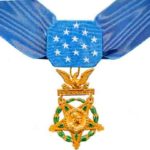 The Medal of Honor was established by Joint Resolution of Congress on 12 July 1862. It is awarded by the President of the United States in the name of Congress. The recipient is one who, while a member of the Army, distinguishes themselves conspicuously by gallantry and intrepidity at the risk of his or her life above and beyond the call of duty while engaged in an action against an enemy of the United States.
The Medal of Honor was established by Joint Resolution of Congress on 12 July 1862. It is awarded by the President of the United States in the name of Congress. The recipient is one who, while a member of the Army, distinguishes themselves conspicuously by gallantry and intrepidity at the risk of his or her life above and beyond the call of duty while engaged in an action against an enemy of the United States.
The action must have occurred while engaged in military operations involving conflict with an opposing foreign force; or while serving with friendly foreign forces engaged in an armed conflict against an opposing armed force in which the United States is not a belligerent party.
The deed performed must have been one of personal bravery or self-sacrifice so conspicuous as to clearly distinguish the individual above their comrades and must have involved risk of life. Incontestable proof of the performance of the service will be exacted and each recommendation for the award of this decoration will be considered on the standard of extraordinary merit.
The design of the Medal of Honor is a gold five pointed star, each point tipped with trefoils that is 1 1⁄2 inches (3.8 cm) wide. This is surrounded by a green laurel wreath and suspended from a gold bar inscribed with the word “Valor” that is surmounted by an eagle. In the center of the star lies Minerva’s head surrounded by the words “United States of America”. On each ray of the star is a green oak leaf.
There is a bar engraved on the back side of the medal that reads “The Congress To” with a space for engraving the name of the recipient.” The pendant and suspension bar are made of gilding metal, with the eye, jump rings, and suspension ring made of red brass. The finish on the pendant and suspension bar is hard enameled, gold plated, and rose gold plated, with polished highlights.
Distinguished Service Cross
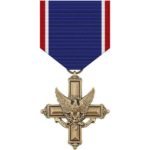 The Distinguished Service Cross was established by Act of Congress on 9 July 1918. It is awarded to a person who, while serving in any capacity with the Army, distinguished himself or herself by extraordinary heroism not justifying the award of a MOH. This must have occurred while engaged in an action against an enemy of the United States while engaged in military operations involving conflict with an opposing or foreign force or while serving with friendly foreign forces engaged in an armed conflict against an opposing armed force in which the United States is not a belligerent party.
The Distinguished Service Cross was established by Act of Congress on 9 July 1918. It is awarded to a person who, while serving in any capacity with the Army, distinguished himself or herself by extraordinary heroism not justifying the award of a MOH. This must have occurred while engaged in an action against an enemy of the United States while engaged in military operations involving conflict with an opposing or foreign force or while serving with friendly foreign forces engaged in an armed conflict against an opposing armed force in which the United States is not a belligerent party.
The act or acts of heroism must have been so notable and have involved risk of life so extraordinary as to set the individual apart from their comrades. The Distinguished Service Cross is a valor award and will not be awarded for achievement or service. This is the primary difference between the awards. The appropriate equivalent award for achievement or service is the Distinguished Service Medal.
The Distinguished Service Cross is a cross of bronze that is 2 inches (5.1 cm) high and 1 13⁄16 inches (46 mm) wide. There is an eagle on the center and a scroll below the eagle bearing the inscription “For Valor”.
On the back side of the medal, the center of the cross is circled by a wreath with a space for engraving the name of the recipient.
Distinguished Service Medal
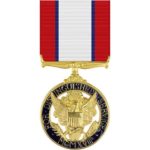 The Distinguished Service Medal was established by Act of Congress on 9 July 1918. It is awarded to any person who, while serving in any capacity with the U.S. Army, has distinguished himself or herself by exceptionally meritorious service to the government in a duty of great responsibility.
The Distinguished Service Medal was established by Act of Congress on 9 July 1918. It is awarded to any person who, while serving in any capacity with the U.S. Army, has distinguished himself or herself by exceptionally meritorious service to the government in a duty of great responsibility.
The performance must be such as to merit recognition for service that is clearly exceptional. Exceptional performance of normal duty will not alone justify an award of the Distinguished Service Medal.
The medal features the Coat of Arms of the United States in Gold surrounded by a circle of Dark Blue enamel. It is 1 ½ inches in diameter, bearing the inscription “For Distinguished Service MCMXVIII”.
On the reverse is a scroll for the name of the recipient (which is to be engraved) upon a trophy of flags and weapons. The medal is suspended by a bar attached to the ribbon.
Silver Star
 The Silver Star was established by Act of Congress on 9 July 1918 . It is awarded to a person who, while serving in any capacity with the United States Army, is cited for gallantry in action against an enemy of the United States while engaged in military operations involving conflict with an opposing foreign force, or while serving with friendly foreign forces engaged in armed conflict against an opposing armed force in which the United States is not a belligerent party. The required gallantry, while of a lesser degree than that required for the Distinguished Service Cross, must nevertheless have been performed with marked distinction.
The Silver Star was established by Act of Congress on 9 July 1918 . It is awarded to a person who, while serving in any capacity with the United States Army, is cited for gallantry in action against an enemy of the United States while engaged in military operations involving conflict with an opposing foreign force, or while serving with friendly foreign forces engaged in armed conflict against an opposing armed force in which the United States is not a belligerent party. The required gallantry, while of a lesser degree than that required for the Distinguished Service Cross, must nevertheless have been performed with marked distinction.
The Silver Star Medal is a gold five-pointed star that is 1 1⁄2 inches (38 mm) in circumscribing diameter with a laurel wreath encircling rays from the center and a 3⁄16 inch (4.8 mm) diameter silver star superimposed in the center. The pendant is suspended from a rectangular shaped metal loop with rounded corners.
The back of the Silver Star medal has the inscription “For Gallantry in Action.”
Legion of Merit
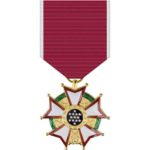 The Legion of Merit was established by Act of Congress on 20 July 1942. It is awarded to any service member of the Armed Forces of the United States or a friendly foreign nation who has distinguished himself or herself by exceptionally meritorious conduct in the performance of outstanding services and achievements.
The Legion of Merit was established by Act of Congress on 20 July 1942. It is awarded to any service member of the Armed Forces of the United States or a friendly foreign nation who has distinguished himself or herself by exceptionally meritorious conduct in the performance of outstanding services and achievements.
This medal is presented in four different forms depending on the degree. The degrees are the Chief Commander, Commander, Officer, and Legionnaire Degrees. These awards are very similar in appearance.
- The Chief Commander Degree features, on a wreath of green laurel joined at the bottom by a gold bow-knot (rosette), a domed five-pointed white star bordered crimson, points reversed with v-shaped extremities tipped with a gold ball. In the center, a blue disk encircled by gold clouds, with 13 white stars arranged in the pattern that appears on the Great Seal of the United States. Between each point, within the wreath are crossed arrows pointing outwards. The overall width is 2 15⁄16 inches (75 mm). The words “United States of America” are engraved in the center of the reverse.
- The Commander Degree features, on a wreath of green laurel joined at the bottom by a gold bow-knot (rosette), a five-pointed white star bordered crimson, points reversed with v-shaped extremities tipped with a gold ball. In the center, a blue disk encircled by gold clouds, with 13 white stars arranged in the pattern that appears on the Great Seal of the United States. Between each star point, within the wreath, are crossed war arrows pointing outwards, representing armed protection to the Nation. The overall width is 2 1⁄4 inches (57 mm). A gold laurel wreath in the v-shaped angle at the top connects an oval suspension ring to the neck ribbon. The back side of the five-pointed star is enameled in white, and the border is crimson. In the center, a disk for engraving the name of the recipient surrounded by the words “Annuit Coeptis MDCCLXXXII”: a combination of the motto from the Great Seal, “He [God] Has Favored Our Undertakings”, with the date for the first award of a US decoration, the Purple Heart. An outer scroll contains the words “UNITED STATES OF AMERICA.” A miniature of the decoration in silver on a horizontal silver bar is worn on the service ribbon.
- The Officer Degree of the Legion of Merit Medal is similar to the degree of Commander except the overall width is 1 7⁄8 inches (48 mm) and the pendant has a suspension ring instead of the wreath for attaching the ribbon. A gold replica of the medal, 3⁄4 inch (19 mm) wide, is centered on the suspension ribbon.
- The Legionnaire Degree of the Legion of Merit Medal and the Legion of Merit Medal issued to U.S. personnel is the same as the degree of Officer, except the suspension ribbon does not have the medal replica.
Distinguished Flying Cross
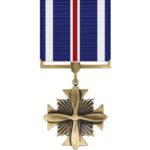 The Distinguished Flying Cross was established by Act of Congress on 2 July 1926. It is awarded to any person who, while serving in any capacity with the Army of the United States, distinguished himself or herself by valor, heroism, or extraordinary achievement while participating in aerial flight.
The Distinguished Flying Cross was established by Act of Congress on 2 July 1926. It is awarded to any person who, while serving in any capacity with the Army of the United States, distinguished himself or herself by valor, heroism, or extraordinary achievement while participating in aerial flight.
The Distinguished Flying Cross is a bronze cross pattee with has a four-bladed propeller superimposed on the front. It is 1 11/16 inches in width. Five rays extend from the reentrant angles, forming a one-inch square.
The back of the medal is blank and suitable for engraving the recipient’s name and rank. The cross is suspended from a rectangular bar.
Soldier’s Medal
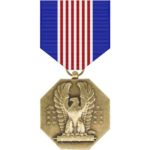 The Soldier’s Medal was established by Act of Congress on 2 July 1926. It is awarded to any person of the Armed Forces of the United States or of a friendly foreign nation who, while serving in any capacity with the Army of the United States, including Reserve Component soldiers not serving in a duty status at the time of the heroic act, who distinguished himself or herself by heroism not involving actual conflict with an enemy.
The Soldier’s Medal was established by Act of Congress on 2 July 1926. It is awarded to any person of the Armed Forces of the United States or of a friendly foreign nation who, while serving in any capacity with the Army of the United States, including Reserve Component soldiers not serving in a duty status at the time of the heroic act, who distinguished himself or herself by heroism not involving actual conflict with an enemy.
The octagon shaped bronze Soldier’s Medal is 1 3/8 inch wide with an eagle displayed, standing on a fasces, between two groups of stars of six and seven, above the group of six a spray of leaves.
On the reverse is a shield divided into equal vertical stripes of 13 pieces. On the chief, are the letters “US,” supported by sprays of laurel and oak, around the upper edge lies the inscription “Soldier’s Medal” and across the face the words “For Valor.” A panel for the name of the recipient to be engraved is at the base. The medal is suspended from the ribbon by a rectangular-shaped metal loop with corners rounded.
Bronze Star Medal
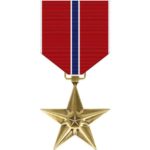 The Bronze Star Medal was established on 4 February 1944. It is awarded to any person who, while serving in any capacity in or with the Armed Forces of the United States, or a friendly foreign nation, after 6 December 1941, distinguished himself or herself by heroic or meritorious achievement or service, not involving participation in aerial flight. This must be in connection with military operations against an armed enemy and in military operations involving conflict with an opposing armed force in which the United States is not a belligerent party.
The Bronze Star Medal was established on 4 February 1944. It is awarded to any person who, while serving in any capacity in or with the Armed Forces of the United States, or a friendly foreign nation, after 6 December 1941, distinguished himself or herself by heroic or meritorious achievement or service, not involving participation in aerial flight. This must be in connection with military operations against an armed enemy and in military operations involving conflict with an opposing armed force in which the United States is not a belligerent party.
The medal is a bronze star that is 1 1⁄2 inches (38 mm) in circumscribing diameter. In the center is a 3⁄16 inch (4.8 mm) diameter superimposed bronze star, the centerline of all rays of both stars coinciding.
The back of the Bronze Star Medal bears the inscription “Heroic or Meritorious Achievement”. There is a space for the name of the recipient to be engraved. The medal hangs from its ribbon by a rectangular metal loop with rounded corners.
Meritorious Service Medal
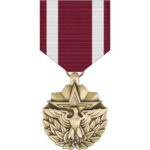 The Meritorious Service Medal was established on 28 March 2003. It is awarded to any service member of the Armed Forces of the United States or to any member of the armed forces of a friendly foreign nation who has distinguished himself or herself by outstanding meritorious achievement or service.
The Meritorious Service Medal was established on 28 March 2003. It is awarded to any service member of the Armed Forces of the United States or to any member of the armed forces of a friendly foreign nation who has distinguished himself or herself by outstanding meritorious achievement or service.
The Meritorious Service Medal is bronze at 1.5 inches in diameter overall. It consists of six rays issuant from the upper three points of a five-pointed star with beveled edges and containing two smaller stars defined by incised outlines. In front of the lower part of the star, there is an eagle with wings upraised standing upon two upward curving branches of laurel tied with a ribbon between the feet of the eagle.
The back side of the medal has the encircled inscriptions “United States of America” and “Meritorious Service.”
Air Medal
 The Air Medal was established on 11 September 1942. It is awarded to any person who, while serving in any capacity in or with the Armed Forces of the United States, who has distinguished himself or herself by meritorious achievement while participating in aerial flight. Awards may be made to recognize single acts of valor, merit or heroism, or for meritorious service.
The Air Medal was established on 11 September 1942. It is awarded to any person who, while serving in any capacity in or with the Armed Forces of the United States, who has distinguished himself or herself by meritorious achievement while participating in aerial flight. Awards may be made to recognize single acts of valor, merit or heroism, or for meritorious service.
The Air Medal features a bronze compass rose that is 111⁄16 inches circumscribing diameter and charged with an eagle volant carrying two lightning flashes in its talons on its face. A fleur-de-lis at the top point holds the suspension ring.
On the back side of the medal, the points of the compass rose is modeled with the central portion plain for engraving the name of the recipient.
Army Commendation Medal
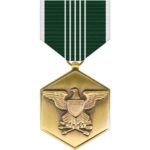 The Army Commendation Medal was established on 18 December 1945. It is awarded to any service member of the Armed Forces of the United States who, while serving in any capacity with the Army after 6 December 1941, distinguishes himself or herself by heroism, meritorious achievement, or meritorious service. Foreign service members of a friendly foreign nation who distinguish themselves by an act of heroism, extraordinary achievement, or meritorious service, which has been of mutual benefit to a friendly nation and the United States.
The Army Commendation Medal was established on 18 December 1945. It is awarded to any service member of the Armed Forces of the United States who, while serving in any capacity with the Army after 6 December 1941, distinguishes himself or herself by heroism, meritorious achievement, or meritorious service. Foreign service members of a friendly foreign nation who distinguish themselves by an act of heroism, extraordinary achievement, or meritorious service, which has been of mutual benefit to a friendly nation and the United States.
The medallion of the Army Commendation Medal is a bronze hexagon that is 13⁄8 inches wide. There is an American bald eagle with wings spread horizontally, on the face of the medallion, grasping in its talons three crossed arrows. On the eagle’s breast is a shield with equally divided stripes of thirteen pieces and a chief.
The back of the Army Commendation Medal bears a panel for naming between the words “For Military” above and “Merit” below, and a laurel sprig below.
Army Achievement Medal
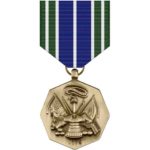 The Army Achievement Medal was established by the Secretary of the Army on 10 April 1981. It is awarded to any member of the Armed Forces of the United States, or to any member of the armed forces of a friendly foreign nation, who distinguished himself or herself by meritorious service or achievement of a lesser degree than required for award of the Army Commendation Medal.
The Army Achievement Medal was established by the Secretary of the Army on 10 April 1981. It is awarded to any member of the Armed Forces of the United States, or to any member of the armed forces of a friendly foreign nation, who distinguished himself or herself by meritorious service or achievement of a lesser degree than required for award of the Army Commendation Medal.
Army Achievement Medal is a Bronze octagon shaped medal with one angle centered at the top and is 1 ½ inches in diameter. The front of the medal features a rudimentary Department of the Army plaque with the date “1775” across the bottom.
The back side has the words “For Military Achievement” written on three lines. A blank space for a name is below along with two slips of laurel on the reverse side.
Good Conduct Medal / Army Reserve Components Achievement Medal
Good Conduct and Achievement Medals
Army Good Conduct Medal
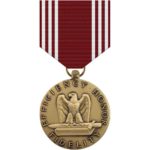 The Army Good Conduct Medal was established on 28 June 1941. It is awarded for exemplary behavior, efficiency, and fidelity in active Federal military service. It is awarded on a selective basis to each Soldier who distinguishes himself or herself from among his or her fellow Soldiers by exemplary conduct, efficiency, and fidelity throughout a specified period of continuous enlisted active Federal military service.
The Army Good Conduct Medal was established on 28 June 1941. It is awarded for exemplary behavior, efficiency, and fidelity in active Federal military service. It is awarded on a selective basis to each Soldier who distinguishes himself or herself from among his or her fellow Soldiers by exemplary conduct, efficiency, and fidelity throughout a specified period of continuous enlisted active Federal military service.
The Army Good Conduct Medal is bronze and circular at 1 1/4 inches in diameter. The face of the medal features an eagle with wings spread, standing on a closed book and sword. It is encircled by the words “Efficiency Honor Fidelity”.
The back side features a five-pointed star and a scroll between the words “For Good” and “Conduct”. The words are surrounded by a wreath formed by a laurel branch on the left and an oak branch on the right.
Army Reserve Components Achievement Medal
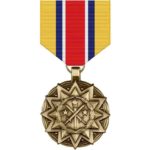 The Army Reserve Components Achievement Medal was established by the Secretary of the Army on 3 March 1971. It is awarded for exemplary behavior, efficiency, and fidelity while serving as a member of one of the Army Reserve components. There are two designs; the first bears the inscription “United States Army Reserve” while the other bears the inscription “Army National Guard.”
The Army Reserve Components Achievement Medal was established by the Secretary of the Army on 3 March 1971. It is awarded for exemplary behavior, efficiency, and fidelity while serving as a member of one of the Army Reserve components. There are two designs; the first bears the inscription “United States Army Reserve” while the other bears the inscription “Army National Guard.”
The Reserve Components Achievement Medal is a Bronze and 1 ¼ inches in diameter. The front side has a beveled edge twelve-pointed star with the points of the star lying over a laurel wreath. Centered in the star is a smaller laurel wreath with a torch between two swords pointed upward. The swords are crossed and bordered by two mullets.
The back side features a cuirass from the Department of the Army seal. Above the seal are the words “Army National Guard” or “United States Army Reserve”. The words “FOR ACHIEVEMENT” are below.

Army Service Medals and Service Ribbons
Service (campaign) medals and service ribbons serve to denote honorable performance of military duty within specified limited dates in specified geographical areas. With the exception of the Army Service Ribbon, the Noncommissioned Officer Professional Development Ribbon, and the Army Reserve Components Overseas Training Ribbon, service medals and service ribbons are awarded only for active Federal military service.
Service Medals and Ribbons
Army Reserve Components Overseas Training Ribbon
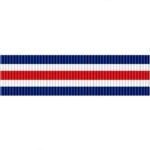 The Army Reserve Components Overseas Training Ribbon was established by the Secretary of the Army on 11 July 1984. It is awarded to members of the reserve components of the Army (ARNG and USAR), for successful completion of annual training or Active Duty Training for a period not less than 10 consecutive duty days on foreign soil.
The Army Reserve Components Overseas Training Ribbon was established by the Secretary of the Army on 11 July 1984. It is awarded to members of the reserve components of the Army (ARNG and USAR), for successful completion of annual training or Active Duty Training for a period not less than 10 consecutive duty days on foreign soil.
All ARNG and USAR Soldiers who accompany the reserve component unit (including unit cells) to which they are assigned or attached as active duty for operational support during overseas training are also eligible for the award.
Overseas Service Ribbon
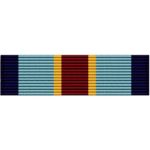 The Overseas Service Ribbon was established by the Secretary of the Army on 10 April 1981. It is awarded to Soldiers of the U.S. Army for successful completion of overseas tours.
The Overseas Service Ribbon was established by the Secretary of the Army on 10 April 1981. It is awarded to Soldiers of the U.S. Army for successful completion of overseas tours.
Army Service Ribbon
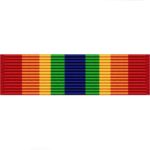 The Army Service Ribbon was established by the Secretary of the Army on 10 April 1981. It is awarded to Soldiers of the U.S. Army for successful completion of initial entry training. The ribbon may be awarded retroactively to those personnel who completed the required training before 1 August 1981 provided they had an Regular Army status as defined above on or after 1 August 1981.
The Army Service Ribbon was established by the Secretary of the Army on 10 April 1981. It is awarded to Soldiers of the U.S. Army for successful completion of initial entry training. The ribbon may be awarded retroactively to those personnel who completed the required training before 1 August 1981 provided they had an Regular Army status as defined above on or after 1 August 1981.
Noncommissioned Officer Professional Development Ribbon
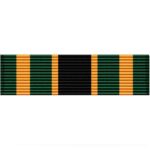 The Noncommissioned Officer Professional Development Ribbon was established by the Secretary of the Army on 10 April 1981. It is awarded to Regular Army, Army National Guard, and United States Army Reserve soldiers for successful completion of designated NCO professional development courses.
The Noncommissioned Officer Professional Development Ribbon was established by the Secretary of the Army on 10 April 1981. It is awarded to Regular Army, Army National Guard, and United States Army Reserve soldiers for successful completion of designated NCO professional development courses.
Army Sea Duty Ribbon
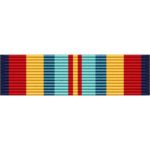 The Army Sea Duty Ribbon was established on 17 April 2006. It is awarded to Soldiers of the Regular Army, the Army National Guard, and the United States Army Reserve for completion of designated periods of sea duty aboard Class A and Class B U.S. Army Vessels.
The Army Sea Duty Ribbon was established on 17 April 2006. It is awarded to Soldiers of the Regular Army, the Army National Guard, and the United States Army Reserve for completion of designated periods of sea duty aboard Class A and Class B U.S. Army Vessels.
Army of Occupation Medal
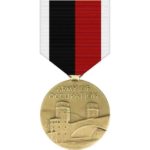 The Army of Occupation Medal was established in 1946. It is awarded for service for 30 consecutive days at a normal post of duty (as contrasted to inspector, visitor, courier, escort, passenger, TDY, or detached service) while assigned to either Germany, Italy, Austria, or Japan.
The Army of Occupation Medal was established in 1946. It is awarded for service for 30 consecutive days at a normal post of duty (as contrasted to inspector, visitor, courier, escort, passenger, TDY, or detached service) while assigned to either Germany, Italy, Austria, or Japan.
The circular bronze medal measures 1.25 inches across. On the front of the medal, are the abutments of the Remagen Bridge with the words “Army of Occupation” inscribed above.
The back side features Mount Fuji with a low hanging cloud over two Japanese junks above a wave. The date “1945” is inscribed. A bronze clasp 0.125 inches wide and 1.5 inches in length with the word “Germany” or “Japan” is worn on the suspension ribbon to indicate service in Europe or the Far East.
Army of Occupation of Germany Medal
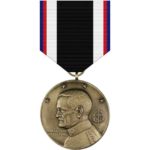 The Army of Occupation of Germany Medal was established by an Act of Congress on 21 November 1941. It is awarded for service in Germany or Austria-Hungary between 12 November, 1918 and 11 July, 1923.
The Army of Occupation of Germany Medal was established by an Act of Congress on 21 November 1941. It is awarded for service in Germany or Austria-Hungary between 12 November, 1918 and 11 July, 1923.
The circular bronze medal measures 1 ¼ inches in diameter.
The front depicts the profile of General John J. Pershing encircled by four stars.
On the back, the inscription “General John J. Pershing” is in the lower left. In the lower right is a laurel wreath superimposed by a sword with the dates “1918” and “1923” enclosed by the wreath.
World War I Victory Medal
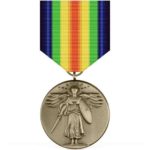 The World War I Victory Medal was established in 1919. The medal is awarded for service between 6 April, 1917 and 11 November, 1918 or with either the American Expeditionary Forces in European Russia or the American Expeditionary Forces Siberia.
The World War I Victory Medal was established in 1919. The medal is awarded for service between 6 April, 1917 and 11 November, 1918 or with either the American Expeditionary Forces in European Russia or the American Expeditionary Forces Siberia.
The front of the circular bronze medal features a winged Victory holding a shield and sword.
The back of the bronze medal features “The Great War For Civilization” in all capital letters curved along the top of the medal. Curved along the bottom of the back of the medal are six stars, three on either side of the center column of seven staffs wrapped in a cord. The top of the staff has a round ball on top and is winged on the side. The staff is on top of a shield that says “U” on the left side of the staff and “S” on the right side of the staff.
On left side of the staff it lists one World War I Allied country per line (France, Italy, Serbia, Japan, Montenegro, Russia, and Greece). On the right side of the staff the Allied country names of Great Britain, Belgium, Brazil, Portugal, Rumania (spelled with a U instead of an O as it is spelled now), and China.
Civil War Campaign Medal
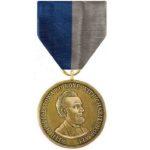 This medal was established in 1907. It is awarded to members of the United States Armed Forces who had served in the American Civil War between 1861 and 1865. The front of the medal displayed an engraved image of Abraham Lincoln. The back side of the medal has the words “The Civil War 1861-1865” encircled by a wreath.
This medal was established in 1907. It is awarded to members of the United States Armed Forces who had served in the American Civil War between 1861 and 1865. The front of the medal displayed an engraved image of Abraham Lincoln. The back side of the medal has the words “The Civil War 1861-1865” encircled by a wreath.
Indian Campaign Medal
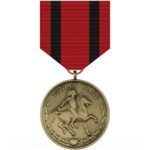 The Indian Campaign Medal was established in 1907. It is awarded (retroactively) to any soldier of the United States Army who had participated in the American Indian Wars against the Native Americans between 1865 and 1891. It is a circular medal of bronze and is 1.25 inches in diameter.
The Indian Campaign Medal was established in 1907. It is awarded (retroactively) to any soldier of the United States Army who had participated in the American Indian Wars against the Native Americans between 1865 and 1891. It is a circular medal of bronze and is 1.25 inches in diameter.
The face of the medal displays a mounted Indian facing sinister, wearing a war bonnet, and carrying a spear in his right hand. The words ‘‘Indian Wars’’ are above and below, on either side of a buffalo skull. The circle is completed by arrowheads, conventionally arranged.
The back of the medal features an eagle perched on a cannon supported by crossed flags, rifles, an Indian shield, spear, and quiver of arrows, a Cuban machete, and a Sulu kriss. The words ‘‘For Service” are below. The entire design is surrounded by a circle composed of the words ‘‘United States Army’’ in the upper half and thirteen stars in the lower half.
Spanish Campaign Medal
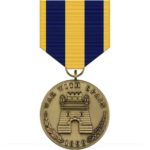 The Spanish Campaign Medal was established in 1905. It is awarded for service those members of the U.S. military who had served in the Spanish–American War. The geographical regions include either Cuba, Puerto Rico, or the Philippine Islands.
The Spanish Campaign Medal was established in 1905. It is awarded for service those members of the U.S. military who had served in the Spanish–American War. The geographical regions include either Cuba, Puerto Rico, or the Philippine Islands.
The circular bronze medallion is 1 ¼ inches in diameter. The face of the medal features a castle with two small round towers at the corners. At the top around the outside edge of the medal is the inscription ”War with Spain”. At the bottom is the date ”1898”, to the left of the date is a branch of tobacco plant, and to the right, a stalk of sugarcane.
The backside features spread eagle on a trophy consisting of a cannon, six rifles and four standards, an Indian shield, quiver of arrows and three spears, a Cuban machete and a Sulu kris. Below the trophy are the words ”For Service”. The whole is surrounded by a circle composed of the words ”United States Army” in the upper half and thirteen stars in the lower half.
Spanish War Service Medal
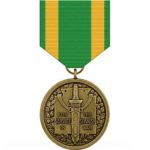 This medal was established by an Act of Congress on 9 July, 1918. It is similar in nature to the Spanish Campaign Medal but is awarded to United States Army personnel for service during the Spanish War that are not eligible for the Spanish Campaign Medal.
This medal was established by an Act of Congress on 9 July, 1918. It is similar in nature to the Spanish Campaign Medal but is awarded to United States Army personnel for service during the Spanish War that are not eligible for the Spanish Campaign Medal.
The Spanish War Service Medal is a circular bronze medal that is 1 3⁄8 inches (35 mm) wide. The front features a Roman sword hanging on a tablet bearing the inscription “For Service in the Spanish War. The tablet is surrounded by a wreath, while the sword is sheathed. The back of the medal bears the coat of arms of the United States over a scroll inscribed “For Service” surrounded by a wreath with the insignia of the Infantry at left, Artillery at the bottom and Cavalry at right.
Army of Cuban Occupation Medal
 The Army of Cuban Occupation Medal was established in 1915. It recognizes those service members who performed garrison occupation duty in the United States Protectorate over Cuba, following the close of the Spanish–American War.
The Army of Cuban Occupation Medal was established in 1915. It recognizes those service members who performed garrison occupation duty in the United States Protectorate over Cuba, following the close of the Spanish–American War.
The Army of Cuban Occupation Medal is a circular bronze medal that is 1 3/8 inches in diameter. The front of the medal features the Coat of Arms of Cuba. The inscription “Army of Occupation Military Government of Cuba” travels around the edge. The dates 1898 and 1902 are on either side of the Phrygian cap at the top of the coat of arms.
The back of the medal depicts a spread winged eagle perched upon a trophy of a cannon, rifles, war flags, an Indian shield, quiver of arrows and three spears, a Cuban machete and Sulu kris. Below the trophy are the words “For Service”. The words “United States Army” are arched around the top edge. In the lower half, around the edge, are thirteen five-pointed stars
Army of Puerto Rican Occupation Medal
 The Army of Puerto Rican Occupation Medal was established on 4 February, 1919. It is awarded to those United States Army service members who had performed military occupation duty in Puerto Rico after the close of the Spanish–American War.
The Army of Puerto Rican Occupation Medal was established on 4 February, 1919. It is awarded to those United States Army service members who had performed military occupation duty in Puerto Rico after the close of the Spanish–American War.
The bronze circular Army of Puerto Rican Occupation Medal is 1 1/4 inches wide. The front bears a castle in the center with two small round towers at the corners. Circling the top is the inscription “Army of Occupation of Porto Rico (the “Puerto Rico” of the country was spelled using conventions of the time). The date 1898 is at the bottom with a branch of a tobacco plant on the left and a stalk of sugar cane on the right.
The back of the medal features a spread eagle on a trophy consisting of a cannon, six rifles, four standards, an Indian shield, quiver of arrows with three spears, a Cuban machete, and Sulu kris. Below the trophy are the words “For Service”. The words “United States Army” encircle the upper half and thirteen five-pointed stars in the lower half.
Philippine Campaign Medal
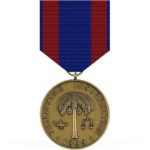 The Philippine Campaign Medal was established in 1905. It is awarded to any United States Army service member who had served in campaigns ashore, on the Philippine Islands. The Army version of the Philippine Campaign Medal is a circular bronze medallion with the words “Philippine Insurrection” centered above the year numeral 1898 with a palm tree and Roman lamp below.
The Philippine Campaign Medal was established in 1905. It is awarded to any United States Army service member who had served in campaigns ashore, on the Philippine Islands. The Army version of the Philippine Campaign Medal is a circular bronze medallion with the words “Philippine Insurrection” centered above the year numeral 1898 with a palm tree and Roman lamp below.
On the back of the medal, there is a trophy composed of an eagle perched on a cannon supported by crossed flags, rifles, an Indian shield, spear, quiver of arrows, a Cuban machete, and a Sulu Kris. Below the trophy are the words ”For Service”. Around the border are the words ”United States Army” in the upper half and thirteen stars in the lower half.
Philippine Congressional Medal
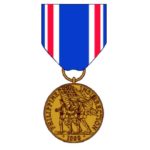 This medal was established by an Act of Congress 29 June 1906. It is awarded to those soldiers who had enlisted in the United States Army for the purpose of the serving in the Philippine–American War. Although similar in intent to the Philippine Campaign Medal, the difference between the two awards is that the Philippine Campaign Medal recognized general service in the Philippines while the Philippine Congressional Medal was intended for special services rendered.
This medal was established by an Act of Congress 29 June 1906. It is awarded to those soldiers who had enlisted in the United States Army for the purpose of the serving in the Philippine–American War. Although similar in intent to the Philippine Campaign Medal, the difference between the two awards is that the Philippine Campaign Medal recognized general service in the Philippines while the Philippine Congressional Medal was intended for special services rendered.
The Philippine Congressional Medal is bronze and circular at 1.25 inches in diameter. The front of the medal depicts a color guard of one flag bearer accompanied by two soldiers bearing rifles, marching toward the left of the medal. Around the edge of the medal are the words “Philippine Insurrection” with the date “1899” below.
The back of the medal bears the inscription “For Patriotism Fortitude and Loyalty” surrounded by a wreath of pine branches on the left and palms on the right, tied at the bottom with a bow.
China Campaign Medal
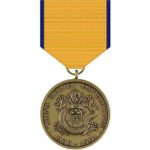 This medal was established in 1905. It is awarded to United States Army personnel for service ashore in China with China Relief Expedition. The expedition was conducted by the United States Army at the turn on the 20th century during the Boxer Rebellion.
This medal was established in 1905. It is awarded to United States Army personnel for service ashore in China with China Relief Expedition. The expedition was conducted by the United States Army at the turn on the 20th century during the Boxer Rebellion.
The front of the medal features the Imperial Chinese five-toed dragon. The inscription “China Relief Expedition” encircles the upper border and the dates 1900–1901 encircle the bottom.
The back features a trophy composed of an eagle perched on a cannon supported by crossed flags, rifles, an Indian shield, spear and quiver of arrows, a Cuban machete, and a Sulu kris. Below the trophy are the words “For Service”. Around the border at the top are the words “United States Army” and around the bottom are thirteen stars.
Army of Cuban Pacification Medal
 This medal was in 1909. It is awarded to United States military personnel for service in Cuba between 6 October, 1906 and 1 April,1909 (the United States occupation of Cuba).
This medal was in 1909. It is awarded to United States military personnel for service in Cuba between 6 October, 1906 and 1 April,1909 (the United States occupation of Cuba).
The front of Army of Cuban Pacification Medal features the coat of arms of Cuba, supported on either side by a soldier in khaki uniform.The words ‘CUBAN PACIFICATION’ are across the top and the dates ‘1906-1909’ are across the bottom.
The back features an eagle with wings displayed, resting upon a trophy consisting of a cannon, six rifles and four standards, an Indian shield, quiver of arrows and three spears, a Cuban machete and a Sulu kris. The whole is enclosed by a circle composed of the words, ‘UNITED STATES ARMY’ in the upper half, and thirteen stars in the lower half.
Mexican Service Medal
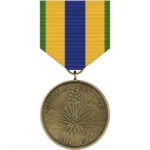 This Mexican Service Medal was established in 1917. It is awarded to those United States service members who performed military service against Mexican forces between the dates of April 12, 1911 and June 16, 1919.
This Mexican Service Medal was established in 1917. It is awarded to those United States service members who performed military service against Mexican forces between the dates of April 12, 1911 and June 16, 1919.
The front of the medal features a Yucca plant in full bloom with mountains in the background. Above the plant appears the words MEXICAN SERVICE around the border and below the plant are the dates 1911-1917.
The back side features a spread eagle on a trophy consisting of a cannon, six rifles and four standards, an Indian shield, quiver of arrows and three spears, a Cuban machete and a Sulu Kris, all above the words FOR SERVICE. Around the border at the top are the words UNITED STATES ARMY and thirteen stars around the bottom.
Mexican Border Service Medal
 This Mexican Border Service Medal was established on 9 July, 1918. It was awarded for service of those those military service members who were assigned to the United States – Mexico border at the period of time when the United States was on the verge of all-out war with Mexico.
This Mexican Border Service Medal was established on 9 July, 1918. It was awarded for service of those those military service members who were assigned to the United States – Mexico border at the period of time when the United States was on the verge of all-out war with Mexico.
The front of the Mexican Border Service Medal features a sheathed Roman sword hanging on a tablet which is inscribed FOR SERVICE ON THE MEXICAN BORDER. The tablet is surrounded by a laurel wreath.
The back of the medal features the Coat of Arms of the United States above a scroll and surrounded by a wreath ending at the center with cross rifles in dexter, crossed sabers in sinister, and crossed cannons in base.

Appurtenances, Lapel Buttons, and Miniature Decorations
Appurtenances are devices affixed to service or suspension ribbons or worn instead of medals or ribbons. They are worn to denote additional awards, participation in a specific event, or other distinguishing characteristics of the award.
The Medal of Honor flag is categorized as an appurtenance of the Medal of Honor.
The Medal of Honor is the only decoration authorized a neck ribbon and the service ribbon is the same color as the neckband, showing five stars in the form of an “M”.
Service Ribbon Appurtenances
Oak leaf clusters
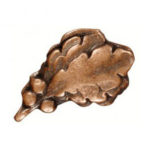 An oak leaf cluster is a bronze or silver twig of four oak leaves with three acorns on the stem, 13/32-inch long for the suspension ribbon, and 5/16-inch long for the service ribbon bar and the unit award. It denotes the award of second and succeeding awards of decorations.
An oak leaf cluster is a bronze or silver twig of four oak leaves with three acorns on the stem, 13/32-inch long for the suspension ribbon, and 5/16-inch long for the service ribbon bar and the unit award. It denotes the award of second and succeeding awards of decorations.
A silver oak leaf cluster is worn instead of five bronze oak leaf clusters. If the number of authorized oak leaf clusters exceeds four, a second ribbon is authorized for wear.
Numerals
 Arabic numerals 3/16 inch in height are issued instead of a medal or ribbon for second and succeeding awards of the Air Medal, Multinational Force and Observers Medal, Overseas Service Ribbon, the Noncommissioned Officer Professional Development Ribbon, Armed Forces Reserve Medal, and the Army Reserve Component Overseas Training Ribbon. The ribbon denotes the first award and numerals starting with the numeral 2 denote the number of subsequent awards.
Arabic numerals 3/16 inch in height are issued instead of a medal or ribbon for second and succeeding awards of the Air Medal, Multinational Force and Observers Medal, Overseas Service Ribbon, the Noncommissioned Officer Professional Development Ribbon, Armed Forces Reserve Medal, and the Army Reserve Component Overseas Training Ribbon. The ribbon denotes the first award and numerals starting with the numeral 2 denote the number of subsequent awards.
“V” Device
 The “V” device is a bronze block letter, V, 1/4-inch high with serifs at the top of either side of the V. It denotes participation in acts of heroism involving conflict with an armed enemy. It is worn on the suspension and service ribbons of the Bronze Star Medal, Air Medal, and Army Commendation Medal, Distinguished Flying Cross or the Joint Service Commendation Medal when the award is for acts of valor.
The “V” device is a bronze block letter, V, 1/4-inch high with serifs at the top of either side of the V. It denotes participation in acts of heroism involving conflict with an armed enemy. It is worn on the suspension and service ribbons of the Bronze Star Medal, Air Medal, and Army Commendation Medal, Distinguished Flying Cross or the Joint Service Commendation Medal when the award is for acts of valor.
“C” Device
 The “C” device signifies meritorious performance “under combat conditions” after January 2016. Although such performance does not rise to the level of valor, it deserves to be distinguished from performance in peacetime or other situations where they are not directly exposed to hostile action or the significant risk of hostile action.
The “C” device signifies meritorious performance “under combat conditions” after January 2016. Although such performance does not rise to the level of valor, it deserves to be distinguished from performance in peacetime or other situations where they are not directly exposed to hostile action or the significant risk of hostile action.
“R” Device
 The “R” device signifies a direct and immediate impact on the outcome of a combat engagement or other military operation, albeit from a location outside the operational area where the service member was neither personally exposed to hostile action, nor at significant risk of exposure to hostile action.
The “R” device signifies a direct and immediate impact on the outcome of a combat engagement or other military operation, albeit from a location outside the operational area where the service member was neither personally exposed to hostile action, nor at significant risk of exposure to hostile action.
“M” Device
 The “M” device signifies Reserve Components who are called to or who volunteer and serve on active duty in support of specific U.S. military operations or contingencies designated by the Secretary of Defense. An Active Guard Reserve member who receives orders changing his or her current duty status, duty location, or assignment to support a contingency operation is also eligible for award of the “M” device.
The “M” device signifies Reserve Components who are called to or who volunteer and serve on active duty in support of specific U.S. military operations or contingencies designated by the Secretary of Defense. An Active Guard Reserve member who receives orders changing his or her current duty status, duty location, or assignment to support a contingency operation is also eligible for award of the “M” device.
Clasps
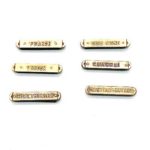 Clasps are authorized for wear on the Army Good Conduct Medal, World War I Victory Medal, Army Distinguished Service Medal, Army of Occupation Medal, and Antarctica Service Medal. All clasps, except for the Army Good Conduct Medal clasp, are worn only on the suspension ribbon of the medal. The clasp is described as follows. It is a bar 1/8-inch by 1 3/8 inches, of bronze, silver, or gold, with loops indicative of each period of service.
Clasps are authorized for wear on the Army Good Conduct Medal, World War I Victory Medal, Army Distinguished Service Medal, Army of Occupation Medal, and Antarctica Service Medal. All clasps, except for the Army Good Conduct Medal clasp, are worn only on the suspension ribbon of the medal. The clasp is described as follows. It is a bar 1/8-inch by 1 3/8 inches, of bronze, silver, or gold, with loops indicative of each period of service.
Service Stars
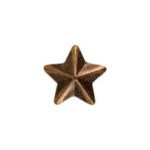 Service stars are worn on campaign and service medals to denote participation in a named campaign and on the service ribbons to denote an additional award. A service star is a bronze or silver five-pointed star 3/16-inch in diameter. A silver service star is worn instead of five bronze service stars. The bronze service star is also affixed to the Parachutist Badge to denote participation in a combat parachutist jump and the Military Free Fall Parachutist Badge to denote participation in a combat military free-fall jump.
Service stars are worn on campaign and service medals to denote participation in a named campaign and on the service ribbons to denote an additional award. A service star is a bronze or silver five-pointed star 3/16-inch in diameter. A silver service star is worn instead of five bronze service stars. The bronze service star is also affixed to the Parachutist Badge to denote participation in a combat parachutist jump and the Military Free Fall Parachutist Badge to denote participation in a combat military free-fall jump.
Arrowhead
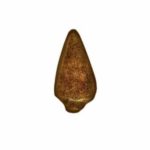 The arrowhead is a bronze replica of an Indian arrowhead 1/4-inch high. It denotes participation in a combat parachute jump, helicopter assault landing, combat glider landing, or amphibious assault landing, while assigned or attached as a member of an organized force carrying out an assigned tactical mission. A Soldier must actually exit the aircraft or watercraft, as appropriate, to receive assault-landing credit.
The arrowhead is a bronze replica of an Indian arrowhead 1/4-inch high. It denotes participation in a combat parachute jump, helicopter assault landing, combat glider landing, or amphibious assault landing, while assigned or attached as a member of an organized force carrying out an assigned tactical mission. A Soldier must actually exit the aircraft or watercraft, as appropriate, to receive assault-landing credit.
Ten-Year Device
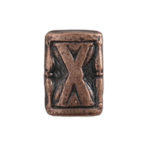 The 10-year device is a bronze, silver and gold hourglass with Roman numeral “X” superimposed 5/16 inch (.79cm) in height to be worn on the service and suspension ribbon of the Armed Forces Reserve Medal. The bronze hourglass indicates 10 years service; silver hourglass indicates 20 years service; gold hourglass indicates 30 years service.
The 10-year device is a bronze, silver and gold hourglass with Roman numeral “X” superimposed 5/16 inch (.79cm) in height to be worn on the service and suspension ribbon of the Armed Forces Reserve Medal. The bronze hourglass indicates 10 years service; silver hourglass indicates 20 years service; gold hourglass indicates 30 years service.
Berlin Airlift Device
 The Berlin Airlift device is a gold-colored metal miniature of a C–54 type aircraft of 3/8-inch wingspan that was awarded for wear on occupation medals and ribbons issued to United States Armed Forces service personnel for participation in or in direct support of, the Berlin airlift during the Cold War.
The Berlin Airlift device is a gold-colored metal miniature of a C–54 type aircraft of 3/8-inch wingspan that was awarded for wear on occupation medals and ribbons issued to United States Armed Forces service personnel for participation in or in direct support of, the Berlin airlift during the Cold War.
Army Astronaut Device
 The Army Astronaut device is a gold-colored device, 7/16 inches in length, consisting of a star emitting three contrails encircled by an elliptical orbit. It is awarded to personnel who complete a minimum of one operational mission in space (50 miles above earth) and is affixed to the appropriate Army Aviator Badge, Flight Surgeon Badge, or Aviation Badge awarded to the astronaut.
The Army Astronaut device is a gold-colored device, 7/16 inches in length, consisting of a star emitting three contrails encircled by an elliptical orbit. It is awarded to personnel who complete a minimum of one operational mission in space (50 miles above earth) and is affixed to the appropriate Army Aviator Badge, Flight Surgeon Badge, or Aviation Badge awarded to the astronaut.
Gold Star Device
 The gold star device is worn on the Army Sea Duty Ribbon to denote the tenth and final award of the ribbon, which is equivalent to 20 years of sea service. The gold star device is a shiny gold star 5/16-inch in diameter.
The gold star device is worn on the Army Sea Duty Ribbon to denote the tenth and final award of the ribbon, which is equivalent to 20 years of sea service. The gold star device is a shiny gold star 5/16-inch in diameter.
Lapel Buttons
Lapel buttons are miniature replicas of military decorations; service medals and ribbons; and identification badges. They are worn only on civilian clothing. The buttons will be worn on the left lapel of civilian clothing for male personnel
and in a similar location for female personnel.
Lapel Buttons for Military Decorations
Lapel buttons for military decorations are issued as either a rosette (1/2-inch in diameter, for the Medal of Honor) or a colored enamel replica (1/8-inch by 21/32-inch) for the service ribbon for other decorations.
Lapel Buttons for Badges
The only badges that have an approved lapel button are the identification badges listed below:
- Presidential Service Badge
- Vice Presidential Service Badge
- Office of the SECDEF Identification Badge
- Joint Chiefs of Staff Identification Badge
- Army Staff Identification Badge
Lapel Buttons for Service
World War I Victory Button
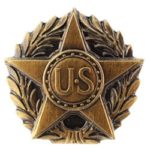 A five-pointed star 5/8-inch in diameter on a wreath with the letters “U.S.” in the center. For persons wounded in action, the lapel button is silver; for all others, the lapel button is bronze. Eligibility requirements are the same for the World War I Victory Medal.
A five-pointed star 5/8-inch in diameter on a wreath with the letters “U.S.” in the center. For persons wounded in action, the lapel button is silver; for all others, the lapel button is bronze. Eligibility requirements are the same for the World War I Victory Medal.
Honorable Service Lapel Button (World War II Victory Medal)
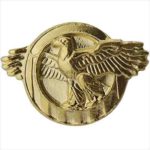 A button of gold-colored metal depicting an eagle perched within a ring composed of a chief and 13 vertical stripes. The button is 7/16-inch high and 5/8-inch wide. Eligibility requirements are honorable Federal military service between 8 September, 1939 and 31 December, 1946.
A button of gold-colored metal depicting an eagle perched within a ring composed of a chief and 13 vertical stripes. The button is 7/16-inch high and 5/8-inch wide. Eligibility requirements are honorable Federal military service between 8 September, 1939 and 31 December, 1946.
Lapel Button for Service Prior to 8 September 1939
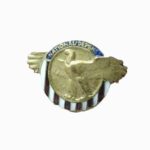 A button 7/16-inch high and 5/8- inch wide, of gold-colored metal that depicts an eagle perched within a ring which displays seven white and six red vertical stripes and a blue chief bearing the words “National Defense.” It may be worn only by a person who served honorably before 8 September, 1939.
A button 7/16-inch high and 5/8- inch wide, of gold-colored metal that depicts an eagle perched within a ring which displays seven white and six red vertical stripes and a blue chief bearing the words “National Defense.” It may be worn only by a person who served honorably before 8 September, 1939.
Army Lapel Button
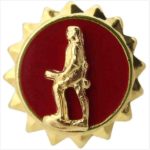 The Army Lapel Button is a gratuitous issue item made up of a gold-colored Minute Man on a red enamel disk surrounded by 16 pointed gold rays with an outside diameter of 9/16-inch. Personnel who have left the Army under honorable conditions are eligible to wear the U.S. Army Lapel Button. Commanders will present the U.S. Army Lapel Button to Army personnel at an appropriate ceremony before their termination of service prior to retirement eligibility.
The Army Lapel Button is a gratuitous issue item made up of a gold-colored Minute Man on a red enamel disk surrounded by 16 pointed gold rays with an outside diameter of 9/16-inch. Personnel who have left the Army under honorable conditions are eligible to wear the U.S. Army Lapel Button. Commanders will present the U.S. Army Lapel Button to Army personnel at an appropriate ceremony before their termination of service prior to retirement eligibility.
U.S. Army Retired Lapel Button
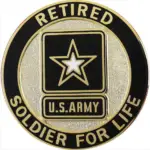 Retired Army personnel to include gray area Soldiers from the Army Reserve and ARNG, are eligible to wear the Army Retired Lapel Button. Commanders will present the lapel button to Army personnel as a part of the Army Retiring Soldier Commendation Program package at an appropriate ceremony prior to retirement.
Retired Army personnel to include gray area Soldiers from the Army Reserve and ARNG, are eligible to wear the Army Retired Lapel Button. Commanders will present the lapel button to Army personnel as a part of the Army Retiring Soldier Commendation Program package at an appropriate ceremony prior to retirement.
The U.S. Army Retired Lapel Button is gold metal consisting of a black background displaying a black star surmounted by a white star; attached around the device is a gold edged black circle with a scroll inscribed “Retired” above and “Soldier for Life” below in gold. The overall dimension is 7/8-inch in diameter
Active Reserve Lapel Button
 The Active Reserve Lapel Button is authorized for active membership in the Ready Reserve of the Army. It is made up of a Minute Man in gold color on a bronze color base and is 11/16-inch in length. The button is an optional purchase item, not issued or sold by DA. It is not worn on the uniform.
The Active Reserve Lapel Button is authorized for active membership in the Ready Reserve of the Army. It is made up of a Minute Man in gold color on a bronze color base and is 11/16-inch in length. The button is an optional purchase item, not issued or sold by DA. It is not worn on the uniform.
Lapel Button for Korean Augmentation to the United States Army
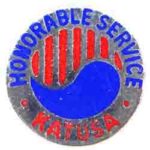 The KATUSA Lapel Button (KLB) was approved by the Secretary of the Army on 22 March 1988 as a gratuitous issue item. It is a round disk with an outside diameter of 9/16-inch that is comprised of a Korean Taegeuk that consists of the characteristics from both the U.S. and Republic of Korea National Flags resting on a white background. The words “Honorable Service KATUSA” are situated on the border of the outer edge of the KLB.
The KATUSA Lapel Button (KLB) was approved by the Secretary of the Army on 22 March 1988 as a gratuitous issue item. It is a round disk with an outside diameter of 9/16-inch that is comprised of a Korean Taegeuk that consists of the characteristics from both the U.S. and Republic of Korea National Flags resting on a white background. The words “Honorable Service KATUSA” are situated on the border of the outer edge of the KLB.
Gold Star Lapel Button
 The Gold Star Lapel Button provides an appropriate identification for widows, widowers, parents, and next of kin of Servicemembers of the Armed Forces of the United States who died in World War I and World War II and subsequent armed hostilities in which the Armed Forces of the United States has been engaged.
The Gold Star Lapel Button provides an appropriate identification for widows, widowers, parents, and next of kin of Servicemembers of the Armed Forces of the United States who died in World War I and World War II and subsequent armed hostilities in which the Armed Forces of the United States has been engaged.
Lapel Button for Primary Next of Kin of Deceased Personnel
 The Lapel Button, Next of Kin of Deceased Personnel is provided to widows and widowers, parents, and primary next of kin of armed service members who lost their lives while serving on active duty or while assigned in USAR or ARNG units in a drill status
The Lapel Button, Next of Kin of Deceased Personnel is provided to widows and widowers, parents, and primary next of kin of armed service members who lost their lives while serving on active duty or while assigned in USAR or ARNG units in a drill status
Army Superior Unit Award Lapel Pin
 The Army Superior Unit Award Lapel Pin is authorized for issue and wear by DA civilians in the employ of units that receive these awards. The lapel pin is also authorized for optional purchase and wear on civilian clothing by qualified military personnel.
The Army Superior Unit Award Lapel Pin is authorized for issue and wear by DA civilians in the employ of units that receive these awards. The lapel pin is also authorized for optional purchase and wear on civilian clothing by qualified military personnel.
Miniature Medals
Miniature Decorations
Miniature replicas of all medals except for the Medal of Honor and the Legion of Merit in the Degrees of Chief Commander and Commander are authorized for wear on certain uniforms instead of the issued medals. Miniatures of decorations are issued only to foreign military personnel and with the award of the Distinguished Service Medal to U.S. personnel.
Miniature Badges
Replicas of combat and special skill badges in miniature size are authorized for wear on certain uniforms instead of the full-size badges.
Medal of Honor Flag
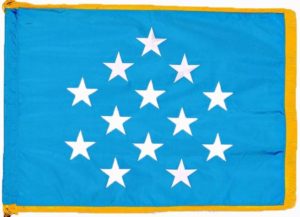 The Medal of Honor Flag is light blue flag with gold fringe bearing thirteen white stars in a configuration as on the Medal of Honor ribbon. It commemorates the sacrifice and blood shed for our freedoms and gives emphasis to the Medal of Honor being the highest award for valor by an individual serving in the Armed Forces of the United States.
The Medal of Honor Flag is light blue flag with gold fringe bearing thirteen white stars in a configuration as on the Medal of Honor ribbon. It commemorates the sacrifice and blood shed for our freedoms and gives emphasis to the Medal of Honor being the highest award for valor by an individual serving in the Armed Forces of the United States.
Unit Awards
Awards are made to organizations when the heroism displayed or meritorious service performed is a result of group effort.
The following unit awards are authorized as recognition of certain types of service, usually during war, as a means of
promoting esprit de corps:
Unit Award Emblems
An individual unit award emblem is authorized for wear on the uniform for the Presidential Unit Citation, Joint Meritorious Unit Award,
Valorous Unit Award, Meritorious Unit Citation, and the Army Superior Unit Award.
Unit Decorations
A U.S. Army advisor to a foreign unit is authorized to wear United States decorations awarded to the foreign unit, as long as the advisor was present and assigned to that unit during the cited action or service.
Presidential Unit Citation
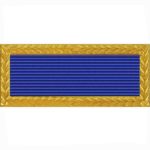 The Distinguished Unit Citation is the predecessor of the Presidential Unit Citation and was redesignated as such on 3 November, 1966. It is awarded to units of the Armed Forces of the United States and co-belligerent nations for extraordinary heroism in action against an armed enemy occurring on or after 7 December, 1941.
The Distinguished Unit Citation is the predecessor of the Presidential Unit Citation and was redesignated as such on 3 November, 1966. It is awarded to units of the Armed Forces of the United States and co-belligerent nations for extraordinary heroism in action against an armed enemy occurring on or after 7 December, 1941.
The unit must display such gallantry, determination, and esprit de corps in accomplishing its mission under extremely difficult and hazardous conditions as to set it apart from and above other units participating in the same campaign.
Valorous Unit Award
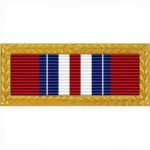 The Valorous Unit Award may be awarded to units of the Armed Forces of the United States and co-belligerent nations for extraordinary heroism in action against an armed enemy of the United States while engaged in military operations involving conflict with an opposing foreign force or while serving with friendly foreign forces engaged in an armed conflict against an opposing armed force in which the United States is not a belligerent party for actions occurring on or after 3 August 1963.
The Valorous Unit Award may be awarded to units of the Armed Forces of the United States and co-belligerent nations for extraordinary heroism in action against an armed enemy of the United States while engaged in military operations involving conflict with an opposing foreign force or while serving with friendly foreign forces engaged in an armed conflict against an opposing armed force in which the United States is not a belligerent party for actions occurring on or after 3 August 1963.
Meritorious Unit Commendation
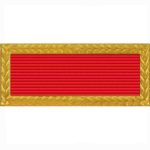 The Meritorious Unit Commendation is awarded to units for exceptionally meritorious conduct in the performance of outstanding services for at least 6 continuous months during the period of military operations against an armed enemy occurring on or after 1 January 1944. Service must be directly related to the combat effort. Units based in CONUS are excluded from this award, as are other units outside the area of operation.
The Meritorious Unit Commendation is awarded to units for exceptionally meritorious conduct in the performance of outstanding services for at least 6 continuous months during the period of military operations against an armed enemy occurring on or after 1 January 1944. Service must be directly related to the combat effort. Units based in CONUS are excluded from this award, as are other units outside the area of operation.
The unit must display such outstanding devotion and superior performance of exceptionally difficult tasks as to set it apart and above other units with similar missions. The degree of achievement required is the same as that which would warrant award of the LM to an individual.
Army Superior Unit Award
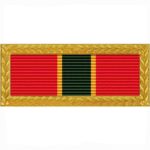 The Army Superior Unit Award was established by the Secretary of the Army on 8 April 1985 to recognize outstanding meritorious performance by a unit during peacetime of a difficult and challenging mission under extraordinary circumstances. Circumstances may be deemed to be extraordinary when they do not represent the typical day-to-day circumstances under which the unit normally performs, or may reasonably be expected to perform, its peacetime mission.
The Army Superior Unit Award was established by the Secretary of the Army on 8 April 1985 to recognize outstanding meritorious performance by a unit during peacetime of a difficult and challenging mission under extraordinary circumstances. Circumstances may be deemed to be extraordinary when they do not represent the typical day-to-day circumstances under which the unit normally performs, or may reasonably be expected to perform, its peacetime mission.
The unit must display such outstanding devotion and superior performance of exceptionally difficult tasks as to set the unit apart from and above other units with similar missions.
Streamers and Devices

![]() Campaign streamers are awarded for active Federal military service to units or organizations that are authorized an organizational color, distinguishing flag or guidon as determined by Center of Military History to recognize receipt of Campaign Participation Credit. They will be awarded ceremoniously in recognition of Campaign Participation Credit.
Campaign streamers are awarded for active Federal military service to units or organizations that are authorized an organizational color, distinguishing flag or guidon as determined by Center of Military History to recognize receipt of Campaign Participation Credit. They will be awarded ceremoniously in recognition of Campaign Participation Credit.
Streamers are used to commemorate the battles, campaigns, service and unit citations of all branches of the US military. Devices are used to accentuate streamers and allow each color-bearing and guidon-bearing element of the regimental family to identify its own contributions to regimental history and tradition and is authorized to identify each honor earned by the element.
Streamers and devices include;
- Campaign Streamers
- War Service Streamers
- Combat Infantry Streamer
- Combat Medical Streamer
- Combat Action Streamer
- Assault – Landing Credit Arrowhead Device
- Expert Infantry Streamer
- Expert Medical Streamer
- Army Safety Excellence Streamer
- Earned Honor Device
Badges and Tabs
The purpose of awarding badges and tabs is to provide public recognition by tangible evidence of the attainment of a high degree of skill, proficiency, and excellence in tests and competition, as well as in the performance of duties.
Combat and special skill badges are awarded to denote proficiency in performance of duties under hazardous conditions and circumstances of extraordinary hardship. This also includes special qualifications and successful completion of prescribed courses of training.
Marksmanship badges and tabs are awarded to indicate the degree in which an individual has qualified in prescribed weapons firing courses or events.
Identification badges are authorized to be worn as public evidence of deserved honor and distinction to denote service performed in specified assignments.
There are four tabs authorized to indicate skill: Ranger, SF, Sapper, and President’s Hundred
Combat Badges
Combat Infantryman Badge
 The Combat Infantryman Badge was established by the War Department on 27 October 1943. It was designed to enhance morale and the prestige of the “Queen of Battle.” The badge was intended as an inducement for individuals to join the infantry while serving as a morale booster for infantrymen serving in every theater.
The Combat Infantryman Badge was established by the War Department on 27 October 1943. It was designed to enhance morale and the prestige of the “Queen of Battle.” The badge was intended as an inducement for individuals to join the infantry while serving as a morale booster for infantrymen serving in every theater.
The Combat Infantryman Badge is an award that would provide special recognition of the unique role of the Army infantryman, the only Soldier whose daily mission is to close with and destroy the enemy and to seize and hold terrain
Combat Medical Badge
 The Combat Medical Badge was created by the War Department on 1 March 1945. It could be awarded to officers, warrant officers, and enlisted Soldier of the Army Medical Department assigned or attached to the medical detachment of infantry regiments, infantry Battalions, and elements thereof designated as infantry in tables of organization.
The Combat Medical Badge was created by the War Department on 1 March 1945. It could be awarded to officers, warrant officers, and enlisted Soldier of the Army Medical Department assigned or attached to the medical detachment of infantry regiments, infantry Battalions, and elements thereof designated as infantry in tables of organization.
Its evolution stemmed from a requirement to recognize medical aid-men who shared the same hazards and hardships of ground combat on a daily basis with the infantry Soldier. Though established almost a year and a half after the CIB, it could be awarded retroactive to 7 December 1941 to fully qualified personnel.
Combat Action Badge
 The Combat Action Badge was approved on 2 May, 2005 to provide special recognition to soldiers who personally engaged, or are engaged by, the enemy. It is intended to serve as a companion to the CIB and CMB to recognize the greatly expanded role of non-infantry Soldiers in active, ground combat. The requirements for award of the CAB are branch and MOS immaterial.
The Combat Action Badge was approved on 2 May, 2005 to provide special recognition to soldiers who personally engaged, or are engaged by, the enemy. It is intended to serve as a companion to the CIB and CMB to recognize the greatly expanded role of non-infantry Soldiers in active, ground combat. The requirements for award of the CAB are branch and MOS immaterial.
Assignment to a combat arms unit or a unit organized to conduct close or offensive combat operations, or performing offensive combat operations, is not required to qualify for the CAB. However, the CAB is not intended to recognize Soldiers who simply serve in a combat zone or imminent danger area. Battle participation credit alone is not sufficient; the unit must have engaged or been engaged by the enemy
Special Skill Badges
Expert Infantryman Badge
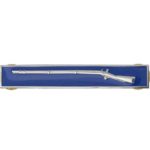 For soldiers to receive the Expert Infantryman Badge, they must meet the prerequisites and take the test with an infantry unit of at least BN size. Personnel must meet all prerequisites and proficiency tests prescribed by U.S. Army Infantry Center Expert Infantryman Badge candidates must be in an Regular Army status and must possess a primary MOS in CMF 11 or CMF 18. They may be warrant officers identified as 180A. They may also be infantry or special operations branch officers serving in infantry positions.
For soldiers to receive the Expert Infantryman Badge, they must meet the prerequisites and take the test with an infantry unit of at least BN size. Personnel must meet all prerequisites and proficiency tests prescribed by U.S. Army Infantry Center Expert Infantryman Badge candidates must be in an Regular Army status and must possess a primary MOS in CMF 11 or CMF 18. They may be warrant officers identified as 180A. They may also be infantry or special operations branch officers serving in infantry positions.
Expert Field Medical Badge
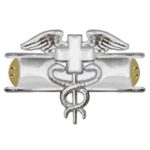 The Expert Field Medical Badge is the non-combat equivalent of the Combat Medical Badge and is awarded to U.S. military personnel and North Atlantic Treaty Organization military personnel who successfully complete a set of qualification tests, including both written and performance portions.
The Expert Field Medical Badge is the non-combat equivalent of the Combat Medical Badge and is awarded to U.S. military personnel and North Atlantic Treaty Organization military personnel who successfully complete a set of qualification tests, including both written and performance portions.
Officers must be assigned or detailed to an AMEDD corps. Warrant officers must have an AMEDD primary MOS controlled by The Surgeon General. Warrant officer pilots are also eligible if they have a “D” skill qualification identifier (SQI) (Aero-medical Evacuation Pilot) and are assigned to an air ambulance unit. Enlisted personnel must have a primary MOS in the medical CMF. Other U.S. Armed Services and foreign military must either be medical personnel or serving in comparable medical positions.
Army Aviator Badges
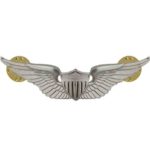
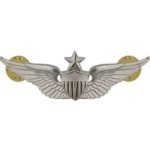

The three degrees of the aviator badges authorized for award are;
(1) Basic Army Aviator Badge
(2) Senior Army Aviator Badge
(3) Master Army Aviator Badge
To be eligible, U.S. officers must have completed the U.S. Army Aviation flight-training course,
At least 1000 flight hours, which must include flight time as a pilot in command and 84 months of rated aviation service for the Senior Aviator Badge. Have at least 2000 flight hours, which must include flight time as a Pilot in Command and 180 months of rate aviation service for the Master Aviator Badge.
Flight Surgeon Badges
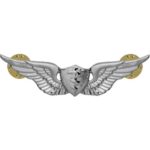


The three levels of Flight Surgeon Badges authorized for award are;
(1) Basic Flight Surgeon Badge
(2) Senior Flight Surgeon Badge
(3) Master Flight Surgeon Badge
The Basic Flight Surgeon Badge may be awarded to those U.S. medical officers who have been awarded an aeronautical designation and to foreign military personnel who complete the training and the requirements.
Requirements for the Senior Flight Surgeon Badge vary, with the time of flying duty (not to be confused with flying time) reduced significantly for officers who have qualified for board certification in aerospace medicine. Senior Flight Surgeons must log ten years of flying duty at that degree, during which they must accumulate a minimum of 850 flying hours, in order to qualify for the Master Flight Surgeon Badge.
Aviation Badges
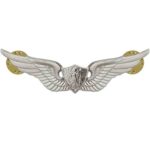

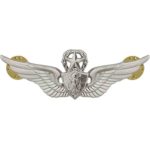
The Aviation Badge is authorized for wear by all Soldiers who successfully earned an MOS in the Aviation Career Management Field. Seven years on flight status or ten years in the CMF will earn a Soldier their Senior Aviation Badge. 15 years on flight status or 17 years in the CMF would allow them to be awarded the Master Aviation Badge.
Explosive Ordnance Disposal Badges
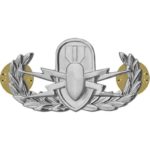
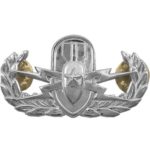

The three types of EOD badges authorized for award are;
(1) Basic Explosive Ordnance Disposal Badge
(2) Senior Explosive Ordnance Disposal Badge
(3) Master Explosive Ordnance Disposal Badge
Any commissioned officer or enlisted Soldier may be awarded the EOD Badge-basic if they successfully complete the conventional render safe qualification as prescribed for the EOD course of instruction, are assigned in a TOE or TDA EOD position for which basic EOD course is a prerequisite, additionally service in a position must be satisfactory for a period of 18 months for the award to be permanent. Additional time requirements must be met for the issuance of the Senior and Master level badges.
Parachutist Badges
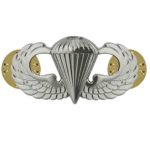
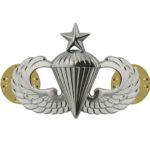

The three types of Parachutist badges authorized for award are;
(1) Basic Parachutist Badge
(2) Senior Parachutist Badge
(3) Master Parachutist Badge
The Army Parachutist Badge is awarded to all military personnel of any service who complete the US Army Basic Airborne Course at Fort Benning, Georgia. It identifies a soldier as a trained military parachutist, and that they are qualified to participate in airborne operations. Senior badge recipients must have participated in a minimum of 30 jumps including fifteen jumps with combat equipment. Master badge recipients must have participated in a minimum of 65 jumps including twenty-five jumps with combat equipment.
Military Free Fall Parachutist Badge
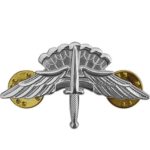 The Military Free Fall Parachutist Badge identifies Special Operations Forces personnel who have qualified in military free-fall parachuting. Two degrees of the Military Free Fall Parachutist Badge are authorized for award, the basic and jumpmaster. To be eligible for the basic badge, an individual must have satisfactorily completed a prescribed program of instruction in military free-fall approved by U.S. Army John F. Kennedy Special Warfare Center and School or have executed a military free-fall combat jump. To be eligible for the Jumpmaster Badge, an individual must have satisfactorily completed a prescribed approved Military Free-Fall Jumpmaster Program of instruction.
The Military Free Fall Parachutist Badge identifies Special Operations Forces personnel who have qualified in military free-fall parachuting. Two degrees of the Military Free Fall Parachutist Badge are authorized for award, the basic and jumpmaster. To be eligible for the basic badge, an individual must have satisfactorily completed a prescribed program of instruction in military free-fall approved by U.S. Army John F. Kennedy Special Warfare Center and School or have executed a military free-fall combat jump. To be eligible for the Jumpmaster Badge, an individual must have satisfactorily completed a prescribed approved Military Free-Fall Jumpmaster Program of instruction.
Pathfinder Badge
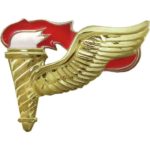 The Pathfinder Badge is awarded to soldiers who complete Pathfinder instruction in advanced land navigation, advanced scouting, tactical air traffic control in the field, and the control of parachute operations. Eligibility requires successful completion of the Pathfinder Course conducted by the U.S. Army Infantry School.
The Pathfinder Badge is awarded to soldiers who complete Pathfinder instruction in advanced land navigation, advanced scouting, tactical air traffic control in the field, and the control of parachute operations. Eligibility requires successful completion of the Pathfinder Course conducted by the U.S. Army Infantry School.
Air Assault Badge
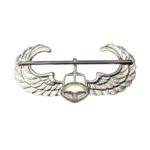 The Air Assault Badge is awarded to soldiers who satisfactorily complete an air assault training course which qualifies soldiers to conduct airmobile and air assault helicopter operations, to include aircraft orientation, sling load operations, proper rappelling techniques and fast-rope techniques.
The Air Assault Badge is awarded to soldiers who satisfactorily complete an air assault training course which qualifies soldiers to conduct airmobile and air assault helicopter operations, to include aircraft orientation, sling load operations, proper rappelling techniques and fast-rope techniques.
Space Badge

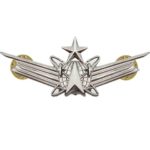
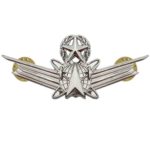
The Space Badge, is a special skills badge for United States Army soldiers derived from the Space Operations Badge (an occupational badge for airman of the United States Air Force).
The three degrees of the Space Badge authorized for award are;
(1) Basic Space Badge
(2) Senior Space Badge
(3) Master Space Badge
Basic eligibility criteria for award are completion of the appropriate space-related education and/or training and serving the required number of months in an Army space cadre approved and/or coded position or performing duties in space mission area. Specific criteria for each level of award and processing procedures are outlined in Army Space Personnel Development Office Procedural Guide #1 located on the Army Space Knowledge Management System website.
Driver and Mechanic Badge
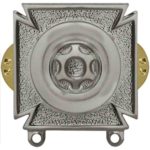 The Driver and Mechanic Badge is awarded to drivers, mechanics, and special equipment operators to denote the attainment of a high degree of skill in the operation and maintenance of motor vehicles and equipment.
The Driver and Mechanic Badge is awarded to drivers, mechanics, and special equipment operators to denote the attainment of a high degree of skill in the operation and maintenance of motor vehicles and equipment.
Component bars are authorized only for the following types of vehicles and/or qualifications:
- Driver-W (for wheeled vehicles)
- Driver-T (for tracked vehicles)
- Driver-M (for motorcycles)
- Driver-A (for amphibious vehicles)
- Mechanic (for automotive or allied vehicles)
- Operator-S (for special mechanical equipment).
Diver Badges

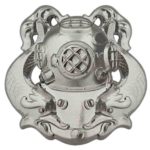


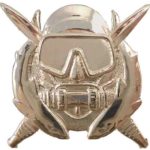
The United States Army issues two different types of diver badges; one for Army engineer divers and one for Army special operations divers. Army engineer diver badges are awarded in four degrees (second-class diver, salvage diver, first-class diver, and master diver) while Army special operations diver badges are awarded in two degrees (diver and diving supervisor).
The five types of diver badges authorized for award are as follows:
(1) Master Diver Badge.
(2) First-Class Diver Badge.
(3) Salvage Diver Badge.
(4) Second-Class Diver Badge.
(5) Special Operations Divers Badge (formerly known as the Scuba Diver Badge).
An individual meeting the qualification requirements for diving rating will be awarded the appropriate diver badge.
Parachute Rigger Badge
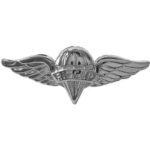 The Parachute Rigger Badge is issued to any individual who successfully completes the Parachute Rigger course conducted by the U.S. Army Quartermaster School and holds an awarded MOS 92R or 921A. Officers qualify upon successful completion of one of the following courses: Aerial Delivery and Materiel Officer Course; Parachute Maintenance and Aerial Supply Officer Course; Parachute Maintenance and Airdrop Course (officer or enlisted); or Parachute Rigger Course (enlisted).
The Parachute Rigger Badge is issued to any individual who successfully completes the Parachute Rigger course conducted by the U.S. Army Quartermaster School and holds an awarded MOS 92R or 921A. Officers qualify upon successful completion of one of the following courses: Aerial Delivery and Materiel Officer Course; Parachute Maintenance and Aerial Supply Officer Course; Parachute Maintenance and Airdrop Course (officer or enlisted); or Parachute Rigger Course (enlisted).
Army Instructor Badges
Basic Army Instructor Badge
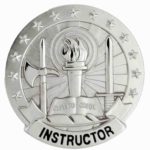 The Basic Army Instructor Badge is awarded to soldiers who meet the TRADOC instructor requirements, complete the instructor certification requirements, successfully complete 80 hours of instruction as a primary instructor, conduct four developmental observations of other instructors, and complete the instructor evaluation requirements established by Commanding General of the Training and Doctrine Command.
The Basic Army Instructor Badge is awarded to soldiers who meet the TRADOC instructor requirements, complete the instructor certification requirements, successfully complete 80 hours of instruction as a primary instructor, conduct four developmental observations of other instructors, and complete the instructor evaluation requirements established by Commanding General of the Training and Doctrine Command.
Senior Army Instructor Badge
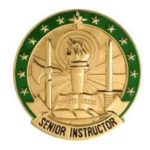 The awarding of the Senior Army Instructor Badge requires a soldiers to meet the TRADOC instructor requirements, serve a minimum of 12 months as a basic instructor, complete Instruction Design Basic Course and the Evaluating Instructors Course, conduct a graded lesson redesign, successfully teach at least 200 hours of instruction as the primary instructor after submission of the BAIB packet, conduct three developmental observations of other instructors, and complete the instructor evaluation requirements established by Commanding General of the Training and Doctrine Command.
The awarding of the Senior Army Instructor Badge requires a soldiers to meet the TRADOC instructor requirements, serve a minimum of 12 months as a basic instructor, complete Instruction Design Basic Course and the Evaluating Instructors Course, conduct a graded lesson redesign, successfully teach at least 200 hours of instruction as the primary instructor after submission of the BAIB packet, conduct three developmental observations of other instructors, and complete the instructor evaluation requirements established by Commanding General of the Training and Doctrine Command.
Master Army Instructor Badge
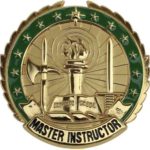 Master Army Instructor Badge awards require that soldiers meet the Trining and Doctrine Command instructor requirements, serve a minimum of 24 months as a senior instructor, successfully teach at least 200 hours of instruction as the primary instructor after submission of the SAIB packet, conduct four Evaluating Instructors Course evaluations of other instructors, complete the instructor evaluation requirements established by Commanding General of Training and Doctrine Command, and be recommended by the Master Instructor Selection Board
Master Army Instructor Badge awards require that soldiers meet the Trining and Doctrine Command instructor requirements, serve a minimum of 24 months as a senior instructor, successfully teach at least 200 hours of instruction as the primary instructor after submission of the SAIB packet, conduct four Evaluating Instructors Course evaluations of other instructors, complete the instructor evaluation requirements established by Commanding General of Training and Doctrine Command, and be recommended by the Master Instructor Selection Board
Glider Badge (rescinded)
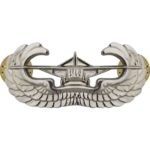 Effective 3 May 1961, the Glider Badge is no longer awarded. An individual who was awarded the badge upon satisfying then current eligibility requirements may continue to wear the badge. It was awarded to soldiers who satisfactorily completed the proficiency tests then prescribed while assigned or attached to an airborne unit or to the Airborne Department of the Infantry School, or by participation in at least one combat glider landing into enemy-held territory as a member of an organized force carrying out an assigned tactical mission for which the unit was credited with an airborne assault landing by the theater commander.
Effective 3 May 1961, the Glider Badge is no longer awarded. An individual who was awarded the badge upon satisfying then current eligibility requirements may continue to wear the badge. It was awarded to soldiers who satisfactorily completed the proficiency tests then prescribed while assigned or attached to an airborne unit or to the Airborne Department of the Infantry School, or by participation in at least one combat glider landing into enemy-held territory as a member of an organized force carrying out an assigned tactical mission for which the unit was credited with an airborne assault landing by the theater commander.
Nuclear Reactor Operator Badges (rescinded)
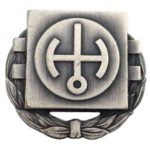 Effective 1 October 1990, the Nuclear Reactor Operator Badges are no longer awarded since the Army no longer conducts nuclear reactor operations or nuclear reactor operator training. Accordingly, the Nuclear Reactor Operator Badges is no longer awarded. Current Army recipients who were permanently awarded any degree of the badge may continue to wear it on the Army uniform
Effective 1 October 1990, the Nuclear Reactor Operator Badges are no longer awarded since the Army no longer conducts nuclear reactor operations or nuclear reactor operator training. Accordingly, the Nuclear Reactor Operator Badges is no longer awarded. Current Army recipients who were permanently awarded any degree of the badge may continue to wear it on the Army uniform

Identification Badges
Eligible Army personnel are authorized to accept and wear identification badges listed below. Identification badges are authorized to be worn as public evidence of deserved honor and distinction to denote service performed in specified assignments;
- In the White House
- In the Office of the Secretary of Defense
- In the Organization of the Joint Chiefs of Staff
- As a member of Headquarters Department of the Army
- As a member of Guard, Tomb of the Unknown Soldier
- As a Military Horseman in the U.S. Army Caisson Platoon
- As a participant in the Army Reserve Officers’ Training Corps Nurse Cadet Program
- As a drill sergeant
- As a U.S. Army recruiter, an ARNG recruiter, or a career counselor.
Presidential Service Badge and Certificate

 The Presidential Service Badge and the Presidential Service Certificate were established on 1 September, 1964. This award replaced the White House Service Badge and Certificate. It is awarded, in the name of the President, by the Secretary of the Army, to service members of the Army who have been assigned to the White House Office, to military units and support facilities under the administration of the White House Military Office, or to other direct support positions with the Executive Office of the President.
The Presidential Service Badge and the Presidential Service Certificate were established on 1 September, 1964. This award replaced the White House Service Badge and Certificate. It is awarded, in the name of the President, by the Secretary of the Army, to service members of the Army who have been assigned to the White House Office, to military units and support facilities under the administration of the White House Military Office, or to other direct support positions with the Executive Office of the President.
The certificate will not be issued to any service member who is issued a Vice Presidential Certificate or similar Executive Office of the President Certificate, for the same period of service. Only one badge will be awarded to an individual regardless of the number of certificates received. The Presidential Service Badge and Certificate may also be awarded posthumously.
Vice Presidential Service Badge and Certificate
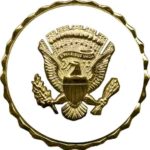 The Vice Presidential Service Badge was established on 19 July, 1976. It is awarded upon recommendation of the Military Assistant to the Vice President, by the Secretary of the Army to U.S. Army personnel who have been assigned to duty in the Office of the Vice President for at least 1 year after 19 December 1974.
The Vice Presidential Service Badge was established on 19 July, 1976. It is awarded upon recommendation of the Military Assistant to the Vice President, by the Secretary of the Army to U.S. Army personnel who have been assigned to duty in the Office of the Vice President for at least 1 year after 19 December 1974.
The badge will be accompanied by a certificate, which is awarded in the same manner in which the badge is given. Once the badge is awarded, it may be worn as a permanent part of the uniform. Only one badge will be awarded to an individual during an administration and only one badge will be awarded to an individual regardless of the number of certificates received. The Vice Presidential Service Badge and Certificate may also be awarded posthumously.
Office of the Secretary of Defense Identification Badge
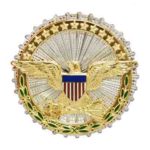 The Office of the Secretary of Defense Identification Badge is authorized for the purpose of providing a distinct identification of military staff members while assigned and, after reassignment, to indicate that the Service member satisfactorily served on the Secretary of Defense’s staff.
The Office of the Secretary of Defense Identification Badge is authorized for the purpose of providing a distinct identification of military staff members while assigned and, after reassignment, to indicate that the Service member satisfactorily served on the Secretary of Defense’s staff.
Joint Chiefs of Staff Identification Badge
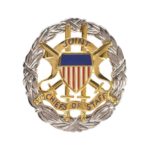 The Joint Chiefs of Staff Identification Badge was established on 3 April 1963. United States personnel (upon assumption of duties) in the following positions are eligible for immediate wear and permanent award of the Joint Chiefs of Staff Identification Badge:
The Joint Chiefs of Staff Identification Badge was established on 3 April 1963. United States personnel (upon assumption of duties) in the following positions are eligible for immediate wear and permanent award of the Joint Chiefs of Staff Identification Badge:
- Joint Chiefs of Staff and Service Vice Chiefs of Staff
- Operations Deputies and Deputy Operations Deputies
- Service Planners
- The four Servicemembers of the Joint Requirements Oversight Council Review Board.
Army Staff Identification Badge
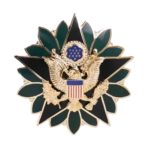 The Army Staff Identification Badge was first proposed by General Douglas MacArthur on 28 December 1931 to recognize outstanding performance of duty while detailed to the Army General Staff. The name was changed to the Army Staff Identification Badge on 29 May 1985 by General John Wickham. The badge is awarded by principal officials of Headquarters of the Department of the Army to military personnel serving on their staff and within their subordinate agencies.
The Army Staff Identification Badge was first proposed by General Douglas MacArthur on 28 December 1931 to recognize outstanding performance of duty while detailed to the Army General Staff. The name was changed to the Army Staff Identification Badge on 29 May 1985 by General John Wickham. The badge is awarded by principal officials of Headquarters of the Department of the Army to military personnel serving on their staff and within their subordinate agencies.
Guard, Tomb of the Unknown Soldier Identification Badge
 The Guard, Tomb of the Unknown Soldier Identification Badge will be authorized by the Commander, 3d U.S. Infantry Regiment (The Old Guard) for wear by each member serving in specified positions at the Tomb of the Unknown Soldier who has met all specified criteria for earning the badge. Only Soldiers serving in the following positions are authorized to earn the badge:
The Guard, Tomb of the Unknown Soldier Identification Badge will be authorized by the Commander, 3d U.S. Infantry Regiment (The Old Guard) for wear by each member serving in specified positions at the Tomb of the Unknown Soldier who has met all specified criteria for earning the badge. Only Soldiers serving in the following positions are authorized to earn the badge:
- Commander of the Guard (platoon leader)
- Sergeant of the Guard (platoon sergeant)
- Commander of the Relief
- Sentinels
Military Horseman Identification Badge
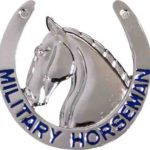 The Military Horseman Identification Badge will be authorized by the Commander, 3d U.S. Infantry Regiment (The Old Guard) for wear by each member serving in the U.S. Army Caisson Platoon who has met all specified criteria for earning the badge. The Commander, 3d U.S. Infantry Regiment (The Old Guard), may authorize the wearing of the Military Horseman Identification Badge as a permanent part of the uniform for certain personnel.
The Military Horseman Identification Badge will be authorized by the Commander, 3d U.S. Infantry Regiment (The Old Guard) for wear by each member serving in the U.S. Army Caisson Platoon who has met all specified criteria for earning the badge. The Commander, 3d U.S. Infantry Regiment (The Old Guard), may authorize the wearing of the Military Horseman Identification Badge as a permanent part of the uniform for certain personnel.
Drill Sergeant Identification Badge
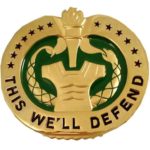 Award of the badge is authorized for the successful completion of the Drill Sergeant Course and assignment as a drill sergeant to a training command. The Commandant of the Drill Sergeant School will authorize the permanent wear of the badge to eligible personnel by memorandum. Officers are authorized to wear this badge if it was permanently awarded to them while in an enlisted status.
Award of the badge is authorized for the successful completion of the Drill Sergeant Course and assignment as a drill sergeant to a training command. The Commandant of the Drill Sergeant School will authorize the permanent wear of the badge to eligible personnel by memorandum. Officers are authorized to wear this badge if it was permanently awarded to them while in an enlisted status.
U.S. Army Recruiter Identification Badges
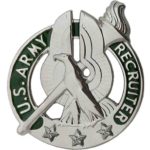 The U.S. Army Basic Recruiter Badge is authorized for wear by military personnel, Regular Army and United States Army Reserve, assigned or attached to the United States Army Recruiting Command. The U.S. Army Gold Recruiter Badge is authorized for wear by eligible personnel meeting the specified criteria. Award of the Gold Recruiter Badge with one, two, or three sapphires was suspended effective 30 September 2010 with eligibility to be determined at a later date. The U.S. Army Master Recruiter Badge is authorized for wear by eligible personnel meeting the current criteria established by United States Army Recruiting Command.
The U.S. Army Basic Recruiter Badge is authorized for wear by military personnel, Regular Army and United States Army Reserve, assigned or attached to the United States Army Recruiting Command. The U.S. Army Gold Recruiter Badge is authorized for wear by eligible personnel meeting the specified criteria. Award of the Gold Recruiter Badge with one, two, or three sapphires was suspended effective 30 September 2010 with eligibility to be determined at a later date. The U.S. Army Master Recruiter Badge is authorized for wear by eligible personnel meeting the current criteria established by United States Army Recruiting Command.
Career Counselor Badge
 The Career Counselor Badge may be authorized for wear by enlisted personnel assigned to authorized duty positions which require primary MOS 79S (career counselor). Officers are authorized to wear the badge if they held an authorized retention primary MOS and met the criteria while in an enlisted status.
The Career Counselor Badge may be authorized for wear by enlisted personnel assigned to authorized duty positions which require primary MOS 79S (career counselor). Officers are authorized to wear the badge if they held an authorized retention primary MOS and met the criteria while in an enlisted status.
Army National Guard Recruiting and Retention Identification Badges
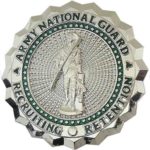 The National Guard Bureau is the proponent agency for these badges. There are three degrees of badges that may be awarded-basic, senior, and master ARNG Recruiter Badges. The basic badge is unique in its design while the senior and expert badges are similar in appearance with the expert badge displaying the words “Peritus” in a gold arch at the top of the badge.
The National Guard Bureau is the proponent agency for these badges. There are three degrees of badges that may be awarded-basic, senior, and master ARNG Recruiter Badges. The basic badge is unique in its design while the senior and expert badges are similar in appearance with the expert badge displaying the words “Peritus” in a gold arch at the top of the badge.
United States Army Reserve Recruiter Identification Badge (rescinded)
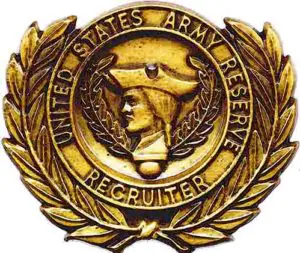 The USAR Recruiter Badge no longer exists as a separate identification badge. In June 2001, the United States Army declared the award discontinued in favor of the standard Recruiter Badge used by both active duty and reserve recruiters.
The USAR Recruiter Badge no longer exists as a separate identification badge. In June 2001, the United States Army declared the award discontinued in favor of the standard Recruiter Badge used by both active duty and reserve recruiters.
Marksmanship Badges and Tabs
U.S. Army Basic Marksmanship Qualification Badges
A Basic Marksmanship Qualification Badge is awarded to indicate the degree in which an individual, military, or civilian has qualified in a prescribed record course, and an appropriate bar is furnished to denote each weapon with which he or she qualified. Each bar will be attached to the basic badge that indicates the qualification last attained with the respective weapon.
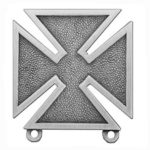
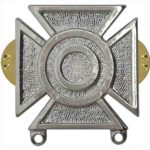
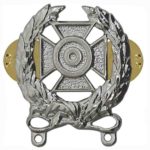
Basic qualification badges are of three classes: Expert, Sharpshooter, and Marksman. Basic Marksmanship Qualification Badges are awarded to U.S. military and civilian personnel, and to foreign military personnel who qualify as prescribed.
Ranger Tab
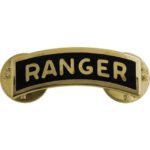 The Ranger Tab is authorized for award to United States military and civilian personnel, and foreign military personnel who qualify as prescribed. The basic eligibility criteria for award of the Ranger Tab requires successful completion of a Ranger course conducted by the U.S. Army Infantry School or conducted by the Ranger Training Command at Fort Benning, GA.
The Ranger Tab is authorized for award to United States military and civilian personnel, and foreign military personnel who qualify as prescribed. The basic eligibility criteria for award of the Ranger Tab requires successful completion of a Ranger course conducted by the U.S. Army Infantry School or conducted by the Ranger Training Command at Fort Benning, GA.
Any person who was awarded the CIB while serving during World War II as a member of a Ranger BN (1st through 6th inclusive) or in the 5307th Composite Unit (Provisional) and 475th Infantry Regiment (Merrill’s Marauders) may also wear the award.
Special Forces Tab
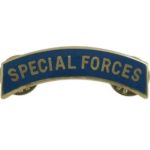 Any person who successfully completes a United States Army John F. Kennedy Special Warfare Center and School approved Regular Army institutional training leading to Special Forces qualification., the reserve component Special Forces qualification program, or an authorized unit-administered SF qualification program.
Any person who successfully completes a United States Army John F. Kennedy Special Warfare Center and School approved Regular Army institutional training leading to Special Forces qualification., the reserve component Special Forces qualification program, or an authorized unit-administered SF qualification program.
Sapper Tab
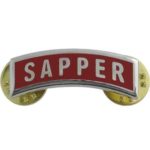 The Sapper Tab was established on 28 June 2004. It is authorized for award to U.S. military and civilian personnel and foreign military personnel who meet the prescribed eligibility criteria.Eligibility requires successful completion of all graduation requirements and a graduation certificate from a Sapper Leaders Course conducted by the U.S. Army Engineer School at Fort Leonard Wood, MO.
The Sapper Tab was established on 28 June 2004. It is authorized for award to U.S. military and civilian personnel and foreign military personnel who meet the prescribed eligibility criteria.Eligibility requires successful completion of all graduation requirements and a graduation certificate from a Sapper Leaders Course conducted by the U.S. Army Engineer School at Fort Leonard Wood, MO.
Physical Fitness Badge
 The Physical Fitness Badge was established by the Secretary of the Army on 25 June 1986. Soldiers who obtain a minimum score of 270 or above, with a minimum of 90 points per event, on the Army Physical Fitness Test and meet the body fat standards will be awarded the Physical Fitness Badge for Physical Fitness Excellence. Soldiers are required to meet the above criteria each record test to continue to wear the badge.
The Physical Fitness Badge was established by the Secretary of the Army on 25 June 1986. Soldiers who obtain a minimum score of 270 or above, with a minimum of 90 points per event, on the Army Physical Fitness Test and meet the body fat standards will be awarded the Physical Fitness Badge for Physical Fitness Excellence. Soldiers are required to meet the above criteria each record test to continue to wear the badge.
U.S. Civilian Marksmanship Program
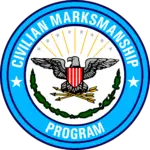 The Civilian Marksmanship Program promotes firearms safety training and rifle practice for all qualified U.S. citizens with special emphasis on youth. The program operates through a network of affiliated shooting clubs and associations that covers every State in the United States.
The Civilian Marksmanship Program promotes firearms safety training and rifle practice for all qualified U.S. citizens with special emphasis on youth. The program operates through a network of affiliated shooting clubs and associations that covers every State in the United States.
The clubs and associations offer firearms safety training and marksmanship courses as well as the opportunity for continued practice and competition. The Civilian Marksmanship Program is administered by the Corporation for the Promotion of Rifle Practice and Firearms Safety, Inc.
President’s Hundred Tab
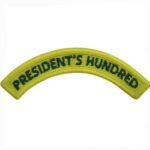 A President’s Hundred Tab is awarded to Soldiers who qualify among the top 100 scoring competitors in the President’s Match held annually at the National Rifle Matches. The National Rifle Association’s (NRA) President’s Match was instituted at the NRA matches of 1878 as the American Military Rifle Championship Match. It was patterned after an event for British Volunteers called the Queen’s Match, which the NRA of Great Britain initiated in 1860.
A President’s Hundred Tab is awarded to Soldiers who qualify among the top 100 scoring competitors in the President’s Match held annually at the National Rifle Matches. The National Rifle Association’s (NRA) President’s Match was instituted at the NRA matches of 1878 as the American Military Rifle Championship Match. It was patterned after an event for British Volunteers called the Queen’s Match, which the NRA of Great Britain initiated in 1860.
In 1884, the name was changed to the President’s Match for the Military Rifle Championship of the United States. The President’s Match was discontinued during World Wars I and II and the Korean War. It was reinstated in 1957 at the National Matches as “The President’s Hundred.” The top-scoring 100 competitors in the President’s Match were singled out for special recognition in a retreat ceremony in which the competitors passed in review before the winner and former winners of this historic match.
The cloth tab was approved for wear on the Army uniform on 3 March 1958. It is a full-color embroidered tab of yellow 4 1/4 inches in length and 5/8 inch in height, with the words “President’s Hundred” centered in 1/4-inch-high green letters.
Foreign and International Decorations and Awards to U.S. Army Personnel
Law. 5 USC 7342 provides for employees of the U.S. Government, including service members of the Armed Forces of the United States, to accept gifts or decorations from a foreign government under certain conditions. No DOD employee may accept, request, or otherwise encourage the offer of a decoration from a foreign government. When possible, employees will refuse to accept such decorations or awards unless refusal would likely cause offense or embarrassment or otherwise adversely affect the foreign relations of the United States.
Subject to restriction, an individual may participate in a ceremony and receive the tender of a foreign decoration. The receipt of the decoration will not constitute acceptance of the award by the recipient. The wearing of unauthorized awards, decorations, or other devices is a violation of the Uniform Code of Military Justice and may subject a Soldier to appropriate disciplinary action.
Foreign Decorations
Individual foreign decorations may be accepted if awarded in recognition of meeting the specified criteria, as established by the foreign government concerned, for the specific award. Only those decorations that are awarded in recognition of military activities and by the military department of the host country are authorized for acceptance and/or wear. Individual decorations that do not meet these criteria may be authorized for acceptance but not for
wear and will not be entered in the Army Military Human Resource Record (AMHRR) of the recipient.
Of particular importance are the criteria established by the military department of the host country; for example, if a particular decoration is authorized for award only to enlisted personnel of host country then the decoration may be accepted and worn by U.S. Army enlisted personnel.
United Nations Service Medal
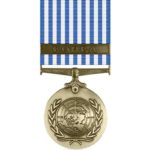 The United Nations Service Medal was established by UN General Assembly Resolution on 12 December, 1950. Awards of the United Nations Service Medal are given to individuals with regard to the following criteria:
The United Nations Service Medal was established by UN General Assembly Resolution on 12 December, 1950. Awards of the United Nations Service Medal are given to individuals with regard to the following criteria:
- Service members of the Armed Forces of the United States dispatched to Korea or adjacent areas for service on behalf of the UN in the action in Korea.
- Other personnel dispatched to Korea or adjacent areas as members of paramilitary and quasi-military units designated by the U.S. Government for service in support of UN action in Korea and certified by the UN Commander in Chief as having directly supported military operations there.
- Personnel awarded the KSM are automatically eligible for award of the United Nations Service Medal.
- Service with a national contingent designated by the U.S. Government for service in support of the UN action in Korea and certified by the UN Commander in Chief as having directly supported military operations in Korea.
Inter-American Defense Board Medal
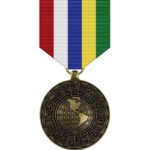 The Inter-American Defense Board Medal was established by the Ninety-First Session of the Inter-American Defense Board on 11 December 1945 and authorized by Executive Order on 18 January, 1969. United States military personnel who have served on the Inter-American Defense Board for at least 1 year as chairman of the board, delegates, advisors, officers of the staff, officers of the secretariat, or officers of the Inter-American Defense College may wear the Inter-American Defense Board ribbon permanently.
The Inter-American Defense Board Medal was established by the Ninety-First Session of the Inter-American Defense Board on 11 December 1945 and authorized by Executive Order on 18 January, 1969. United States military personnel who have served on the Inter-American Defense Board for at least 1 year as chairman of the board, delegates, advisors, officers of the staff, officers of the secretariat, or officers of the Inter-American Defense College may wear the Inter-American Defense Board ribbon permanently.
United States military personnel who have been awarded the Inter-American Defense Board Medal and ribbon may wear them when attending meetings, ceremonies, or other functions where Latin American members of the Board are present.
Philippine Defense Ribbon
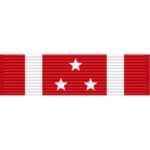 The Philippine Defense Ribbon is awarded for service in the defense of the Philippines from 8 December, 1941 to 15 June, 1942. The conditions of the award require participation in any engagement against the enemy in Philippine territory, in Philippine waters, or in the air over the Philippines or over Philippine waters.
The Philippine Defense Ribbon is awarded for service in the defense of the Philippines from 8 December, 1941 to 15 June, 1942. The conditions of the award require participation in any engagement against the enemy in Philippine territory, in Philippine waters, or in the air over the Philippines or over Philippine waters.
An individual will be considered as having participated in an engagement if they:
- Was a member of the defense garrison of the Bataan Peninsula or of the fortified islands at the entrance to Manila Bay.
- Was a member of and present with a unit actually under enemy fire or air attack.
- Served on a ship that was under enemy fire or air attack.
- Was a crewmember or passenger in an airplane that was under enemy aerial or ground fire.
Philippine Liberation Ribbon
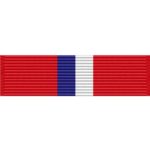 The Philippine Liberation Ribbon was authorized on 8 March, 1948. It is awarded for service in the liberation of the Philippines from 17 October, 1944 to 3 September, 1945.
The Philippine Liberation Ribbon was authorized on 8 March, 1948. It is awarded for service in the liberation of the Philippines from 17 October, 1944 to 3 September, 1945.
Recipients must have participated in the initial landing operations on Leyte or adjoining islands from 17 October 1944 to 20 October 1944, participated in any engagement against the enemy during the campaign on Leyte and adjoining islands, participated in any engagement against the enemy on islands specified other than those , and served in the Philippine Islands or on ships in Philippine waters for no less than 30 days during the period.
Philippine Independence Ribbon
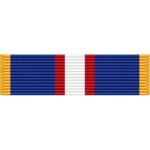 The Philippine Independence Ribbon was in 1948. Any recipient of both the Philippine Defense and Philippine Liberation ribbons is eligible for award of the Philippine Independence Ribbon. U.S. Army personnel authorized to wear the Philippine Independence Ribbon under the established criteria may continue to wear the ribbon, provided the authority for such wear was recorded before 24 November 1954.
The Philippine Independence Ribbon was in 1948. Any recipient of both the Philippine Defense and Philippine Liberation ribbons is eligible for award of the Philippine Independence Ribbon. U.S. Army personnel authorized to wear the Philippine Independence Ribbon under the established criteria may continue to wear the ribbon, provided the authority for such wear was recorded before 24 November 1954.
United Nations Medal
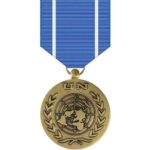 The United Nations Medal (UNM) was established by the Secretary General of the United Nations on 7 January, 1964. United States service members who are or have been in the service of the United Nations in operations designated by the Secretary of Defense may accept the UNM when awarded by the Chief of the UN mission. The eligibility criteria for award of the UNM requires that an individual serve under the operational or tactical control of the UN and serve a minimum of 90 consecutive days in the service of the UN.
The United Nations Medal (UNM) was established by the Secretary General of the United Nations on 7 January, 1964. United States service members who are or have been in the service of the United Nations in operations designated by the Secretary of Defense may accept the UNM when awarded by the Chief of the UN mission. The eligibility criteria for award of the UNM requires that an individual serve under the operational or tactical control of the UN and serve a minimum of 90 consecutive days in the service of the UN.
North Atlantic Treaty Organization Medal
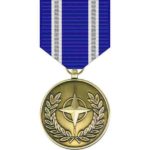 The North Atlantic Treaty Organization (NATO) Medal is awarded by the Secretary General of NATO to military and civilian members of the Armed Forces of the United States who participate in designated NATO operations.
The North Atlantic Treaty Organization (NATO) Medal is awarded by the Secretary General of NATO to military and civilian members of the Armed Forces of the United States who participate in designated NATO operations.
North Atlantic Treaty Organization Meritorious Service Medal
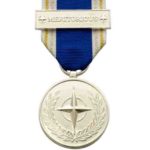 The North Atlantic Treating Organization Meritorious Service Medal is awarded to military and civilian personnel who have been commended for providing exceptional or remarkable service to NATO.
The North Atlantic Treating Organization Meritorious Service Medal is awarded to military and civilian personnel who have been commended for providing exceptional or remarkable service to NATO.
To be eligible for award of the NATO MSM, individuals (both military and civilian) must not have been convicted of serious misconduct or crimes during the period of assignment under NATO command and control, must be serving permanently or temporarily within NATO’s operational chain of command or in those forces under NATO command or control or in a NATO body, and must be commended personally by a commander or a head of a NATO body.
Multinational Force and Observers Medal
 The Multinational Force and Observers (MFO) Medal was established on 24 March, 1982. Recipients for this award must have served with the Multinational Force and Observers for at least 90 cumulative days after 3 August, 1981. Effective 15 March 1985, personnel must serve 6 months (170 days minimum) with the MFO to qualify for the award.
The Multinational Force and Observers (MFO) Medal was established on 24 March, 1982. Recipients for this award must have served with the Multinational Force and Observers for at least 90 cumulative days after 3 August, 1981. Effective 15 March 1985, personnel must serve 6 months (170 days minimum) with the MFO to qualify for the award.
Periods of service on behalf of the MFO outside of Sinai and periods of leave while a service member is serving with the MFO may be counted toward eligibility for the Multinational Force and Observers medal.
Republic of Vietnam Campaign Medal
 The Republic of Vietnam Campaign Medal is awarded by the government of the Republic of Vietnam to service members of the United States Armed Forces who have served in the Republic of Vietnam for 6 months during period a specified period. They may have served outside the geographical limits of the Republic of Vietnam and contributed direct combat support to the Republic of Vietnam and Armed Forces for 6 months. They may have served for less than 6 months and still qualify provided they have:
The Republic of Vietnam Campaign Medal is awarded by the government of the Republic of Vietnam to service members of the United States Armed Forces who have served in the Republic of Vietnam for 6 months during period a specified period. They may have served outside the geographical limits of the Republic of Vietnam and contributed direct combat support to the Republic of Vietnam and Armed Forces for 6 months. They may have served for less than 6 months and still qualify provided they have:
- Been wounded by hostile forces.
- Been captured by hostile forces, but later escaped, was rescued, or released.
- Been killed in action or otherwise in line of duty.
Kuwait Liberation Medal-Saudi Arabia
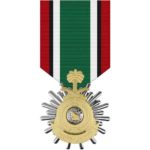 The Kuwait Liberation Medal – Saudi Arabia is awarded by the Government of Saudi Arabia to service members of the Armed Forces of the United States and was authorized on 3 January, 1992.
The Kuwait Liberation Medal – Saudi Arabia is awarded by the Government of Saudi Arabia to service members of the Armed Forces of the United States and was authorized on 3 January, 1992.
It is awarded to service members of the Armed Forces of the United States who participated in Operation DESERT STORM between 17 January, 1991 and 28 February, 1991 in one or more of the following areas: Persian Gulf; Red Sea; Gulf of Oman; that portion of the Arabian Sea that lies north of 10 degree north latitude and west of 68 degree east longitude; the Gulf of Aden; or the total land areas of Iraq, Kuwait, Saudi Arabia, Oman, Bahrain, Qatar, and the United Arab Emirates.
Kuwait Liberation Medal-Government of Kuwait
 The Kuwait Liberation Medal – Government of Kuwait is awarded by the government of Kuwait to service members of the Armed Forces of the United States and was authorized on 7 August, 1995.
The Kuwait Liberation Medal – Government of Kuwait is awarded by the government of Kuwait to service members of the Armed Forces of the United States and was authorized on 7 August, 1995.
It is awarded to Servicemembers of the Armed Forces of the United States who served in support of Operations DESERT SHIELD and DESERT STORM between 2 August, 1990 and 31 August, 1993 in one or more of the following areas: the Arabian Gulf; the Red Sea; the Gulf of Oman; that portion of the Arabian Sea that lies north of 10 degree north latitude and west of 68 degree east longitude; the Gulf of Aden; or the total land areas of Iraq, Kuwait, Saudi Arabia, Oman, Bahrain, Qatar, and the United Arab Emirates.
Korean War Service Medal
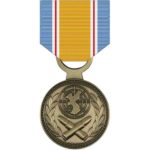 The Korean War Service Medal was originally offered to the Armed Forces of the United States by the Ministry of Defense, Republic of Korea, on 15 November 1951. On 20 August 1999, the Assistant Secretary of Defense (Force Management Policy) approved the acceptance and wear of the medal for veterans of the Korean War.
The Korean War Service Medal was originally offered to the Armed Forces of the United States by the Ministry of Defense, Republic of Korea, on 15 November 1951. On 20 August 1999, the Assistant Secretary of Defense (Force Management Policy) approved the acceptance and wear of the medal for veterans of the Korean War.
It is awarded to Servicemembers of the U.S. Armed Forces who served in Korea and adjacent waters between 25 June, 1950 and 27 July, 1953. The service prescribed must have been performed while on permanent assignment, while on Temporary Duty Assignment (TDY) within the territorial limits of Korea or on waters immediately adjacent thereto (30 consecutive days or 60 nonconsecutive days) or while, as crew members of aircraft, in aerial flight over Korea participating in actual combat operations or in support of combat operations.

Foreign Unit Decorations
Foreign decorations may be awarded during the period of military operations against an armed enemy and for 1 year thereafter. Or, while engaged in military operations involving conflict with an opposing foreign force. Furthermore, they can be awarded while the unit is serving with friendly foreign forces engaged in an armed conflict against an opposing armed force in which the United States is not a belligerent party.
French Fourragere
 The French Fourragere may be awarded by the French government when a unit has been cited twice for the Croix de Guerre. When a unit has been cited four times for the Croix de Guerre, the colors in the Fourragere (green and red) are changed to one in the colors of the Medaille Militaire (yellow and green). The Fourragere in the colors of the Medaille Militaire is the ranking decoration. The award of the Fourragere is not automatic, but requires a specific decree of the French government. Persons who were present in only one action are not authorized to wear the Fourragere.
The French Fourragere may be awarded by the French government when a unit has been cited twice for the Croix de Guerre. When a unit has been cited four times for the Croix de Guerre, the colors in the Fourragere (green and red) are changed to one in the colors of the Medaille Militaire (yellow and green). The Fourragere in the colors of the Medaille Militaire is the ranking decoration. The award of the Fourragere is not automatic, but requires a specific decree of the French government. Persons who were present in only one action are not authorized to wear the Fourragere.
Belgian Fourragere
 The Belgian Fourragere may be awarded by the Belgian government when a unit has been cited twice in the Order of the Day of the Belgian Army. The award of the Fourragere is not automatic, but must be by specific decree of the Belgian government.
The Belgian Fourragere may be awarded by the Belgian government when a unit has been cited twice in the Order of the Day of the Belgian Army. The award of the Fourragere is not automatic, but must be by specific decree of the Belgian government.
Netherlands Orange Lanyard
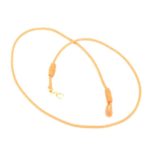 The Orange Lanyard may be awarded by the Netherlands government when a unit has been cited and awarded the Netherlands Military Order of William. It may also be awarded independently. The award of the Orange Lanyard is not automatic, but must be by specific decree of the Netherlands government.
The Orange Lanyard may be awarded by the Netherlands government when a unit has been cited and awarded the Netherlands Military Order of William. It may also be awarded independently. The award of the Orange Lanyard is not automatic, but must be by specific decree of the Netherlands government.
Philippine Republic Presidential Unit Citation
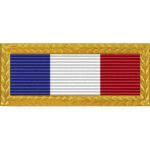 The Philippine Republic Presidential Unit Citation was awarded to certain units of the Armed Forces of the United States in recognition of participation in the war against the Japanese Empire during the periods 7 December, 1941 and 10 May ,1942, inclusive, and 17 October 1944 to 4 July 1945, inclusive. No more than one Philippine Republic Presidential Unit Citation will be worn by an individual and no oak leaf cluster or other appurtenance is authorized.
The Philippine Republic Presidential Unit Citation was awarded to certain units of the Armed Forces of the United States in recognition of participation in the war against the Japanese Empire during the periods 7 December, 1941 and 10 May ,1942, inclusive, and 17 October 1944 to 4 July 1945, inclusive. No more than one Philippine Republic Presidential Unit Citation will be worn by an individual and no oak leaf cluster or other appurtenance is authorized.
It was also awarded to several U.S. military units for outstanding service to the Republic of the Philippines in 1970 and 1972 during disaster relief operations. Lastly, it was awarded to several U.S. military units for outstanding service and support of Exercise BALIKATAN 02 – 1 during the period of 31 January, 2002 to 31 July, 2002.
Republic of Korea Presidential Unit Citation
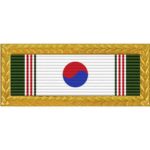 The Republic of Korea Presidential Unit Citation is awarded by the Korean government. No more than one Republic of Korea Presidential Unit Citation will be worn by any individual and no oak leaf cluster or other appurtenance is authorized.
The Republic of Korea Presidential Unit Citation is awarded by the Korean government. No more than one Republic of Korea Presidential Unit Citation will be worn by any individual and no oak leaf cluster or other appurtenance is authorized.
Vietnam Presidential Unit Citation

The Vietnam Presidential Unit Citation was awarded to all personnel assigned to the Military Assistance Advisory Group, Indo-China, during August and September 1954.
Republic of Vietnam Gallantry Cross Unit Citation
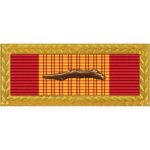 The unit citation of the Gallantry Cross is awarded by the Vietnamese government for valorous combat achievement. It is awarded in four degrees. The degrees include: With Palm (to a unit which is cited before the Armed Forces), With Gold Star (to a unit which is cited before a corps), With Silver Service Star (to a unit which is cited before a division) and With Bronze Star (to a unit which is cited before a regiment or brigade).
The unit citation of the Gallantry Cross is awarded by the Vietnamese government for valorous combat achievement. It is awarded in four degrees. The degrees include: With Palm (to a unit which is cited before the Armed Forces), With Gold Star (to a unit which is cited before a corps), With Silver Service Star (to a unit which is cited before a division) and With Bronze Star (to a unit which is cited before a regiment or brigade).
Republic of Vietnam Civil Actions Unit Citation
 The Republic of Vietnam Civil Actions Unit Citation is awarded by the Vietnamese government for meritorious service. The award of the Civil Actions Unit Citation, First Class, is accompanied with oak leaf clusters. The Palm used in the Republic of Vietnam Gallantry Cross with Palm Unit Citation is the oak leaf device and is worn with the stem to the wearer’s right.
The Republic of Vietnam Civil Actions Unit Citation is awarded by the Vietnamese government for meritorious service. The award of the Civil Actions Unit Citation, First Class, is accompanied with oak leaf clusters. The Palm used in the Republic of Vietnam Gallantry Cross with Palm Unit Citation is the oak leaf device and is worn with the stem to the wearer’s right.
In additions to medals and ribbons, service members may be issued certificates, memorandums, and letters in recognition for service and accomplishments.
Certificates for decorations will be presented with each award of an authorized military decoration. In no case will a commander issue a certificate, indicating award of a military decoration other than on the standard DA certificate for the awarded
decoration.
Letters of appreciation to employers are issued improve employer acceptance of the concept of military leave for participation in Reserve Component training and to encourage employers to adopt liberal military leave policies. Letters of appreciation may be presented to employers who have wholeheartedly and consistently cooperated in granting military leave to employees.
Commanders authorized to award badges may issue, simultaneously, appropriate certificates of achievement to persons under their command who have qualified for the respective badges. However, they are commemorative in nature and do not take the place of the Personnel Order and should not be placed in the AMHHR as an authenticating document for award of a badge.
Acts or services which do not meet the criteria for decorations or the various authorized certificates may be recognized by written or oral expressions of commendation or appreciation. A written expression of commendation or appreciation will be typed on letterhead stationery and will not contain formalized printing, seals, or other distinguishing features which depart from normal letter form. Such letters may be issued to military personnel. Copies of each letter of commendation or appreciation will be distributed to the individual’s AMHRR per AR 600–8–104.
Trophies and similar devices may be presented to military service members, units, or Department of the Army agencies for excellence in accomplishments or competitions which clearly contribute to the increased effectiveness or efficiency of the military unit. Events such as tank gunnery, weapons competition, military aerial competition, and Intramural and athletic competitions may also be recognized.
Summary
The complete reference covering all of the United States Army’s awards and decorations is Army Regulation 600–8–22. It is the Bible in terms of Department of the Army policy, criteria, and administrative instructions. It covers issue to and receipt from both domestic and foreign entities. In addition, it applies to the Regular Army, the Army National Guard/Army National Guard of the United States, and the U.S. Army Reserve awards, unless otherwise stated. Furthermore, it applies to retired military personnel of all branches, foreign military personnel, and Department of Defense Civilians, as indicated.
Awards ensure that our service members receive proper recognition for the acts they perform and the behavior that they display. Their acts and behaviors include acts of valor, exceptional service or achievement, and acts of heroism not involving actual combat do not and should not go unnoticed. To view the order of precedence regarding DOD awards, you can find it in Army Regulation 670–1.
Cheers!
